BPMN 2.0 Constructs
This chapter covers the BPMN 20 constructs supported by Flowable, as well as custom extensions to the BPMN standard.
Custom extensions
The BPMN 2.0 standard is a good thing for all parties involved. End-users don’t suffer from vendor lock-in that comes from depending on a proprietary solution. Frameworks, and particularly open-source frameworks such as Flowable, can implement a solution that has the same (and often better implemented ;-) features as those of a big vendor. Thanks to the BPMN 2.0 standard, the transition from such a big vendor solution towards Flowable can be an easy and smooth path.
The downside of a standard, however, is the fact that it is always the result of many discussions and compromises between different companies (and often visions). As a developer reading the BPMN 2.0 XML of a process definition, sometimes it feels like certain constructs or ways to do things are very cumbersome. As Flowable puts ease of development as a top-priority, we introduced something called the 'Flowable BPMN extensions'. These 'extensions' are new constructs or ways to simplify certain constructs that are not part of the BPMN 2.0 specification.
Although the BPMN 2.0 specification clearly states that it was designed for custom extension, we make sure that:
There always must be a simple transformation to the standard way of doing things, as a prerequisite of such a custom extension. So when you decide to use a custom extension, you don’t have to be concerned that there is no way back.
When using a custom extension, it is always clearly indicated by giving the new XML element, attribute, and so on, the flowable: namespace prefix. Note that the Flowable engine also supports the activiti: namespace prefix.
Whether you want to use a custom extension or not is completely up to you. Several factors will influence this decision (graphical editor usage, company policy, and so on). We only provide them as we believe that some points in the standard can be done in a simpler or more efficient way. Feel free to give us (positive or negative) feedback on our extensions, or to post new ideas for custom extensions. Who knows, some day your idea might pop up in the specification!
Events
Events are used to model something that happens during the lifetime of a process. Events are always visualized as a circle. In BPMN 2.0, there exist two main event categories: catching and throwing events.
Catching: when process execution arrives at the event, it will wait for a trigger to happen. The type of trigger is defined by the inner icon or the type declaration in the XML. Catching events are visually differentiated from a throwing event by the inner icon that is not filled (it’s just white).
Throwing: when process execution arrives at the event, a trigger is fired. The type of trigger is defined by the inner icon or the type declaration in the XML. Throwing events are visually differentiated from a catching event by the inner icon that is filled with black.
Event Definitions
Event definitions define the semantics of an event. Without an event definition, an event "does nothing special". For instance, a start event without an event definition has nothing to specify what exactly starts the process. If we add an event definition to the start event (for example, a timer event definition), we declare what "type" of event starts the process (in the case of a timer event definition, the fact that a certain point in time is reached).
Timer Event Definitions
Timer events are events that are triggered by a defined timer. They can be used as start event, intermediate event or boundary event. The behavior of the time event depends on the business calendar used. Every timer event has a default business calendar, but the business calendar can also be given as part of the timer event definition.
<timerEventDefinition flowable:businessCalendarName="custom">
...
</timerEventDefinition>
Where businessCalendarName points to a business calendar in the process engine configuration. When business calendar is omitted, default business calendars are used.
The timer definition must have exactly one element from the following:
- timeDate. This format specifies a fixed date in ISO 8601 format, when trigger will be fired. For example:
<timerEventDefinition>
<timeDate>2011-03-11T12:13:14</timeDate>
</timerEventDefinition>
- timeDuration. To specify how long the timer should run before it is fired, a timeDuration can be specified as a sub-element of timerEventDefinition. The format used is the ISO 8601 format (as required by the BPMN 2.0 specification). For example (interval lasting 10 days):
<timerEventDefinition>
<timeDuration>P10D</timeDuration>
</timerEventDefinition>
- timeCycle. Specifies a repeating interval, which can be useful for starting process periodically, or for sending multiple reminders for overdue user task. A time cycle element can be in one of two formats. First, is the format of recurring time duration as specified by ISO 8601 standard. Example (3 repeating intervals, each lasting 10 hours):
It is also possible to specify the endDate as an optional attribute on the timeCycle or either in the end of the time expression as follows: R3/PT10H/${EndDate}. When the endDate is reached, the application will stop creating other jobs for this task. It accepts as a value either static values ISO 8601 standard, for example, "2015-02-25T16:42:11+00:00", or variables, for example, ${EndDate}
<timerEventDefinition>
<timeCycle flowable:endDate="2015-02-25T16:42:11+00:00">R3/PT10H</timeCycle>
</timerEventDefinition>
<timerEventDefinition>
<timeCycle>R3/PT10H/${EndDate}</timeCycle>
</timerEventDefinition>
If both are specified, then the endDate specified as attribute will be used by the system.
Currently, only the BoundaryTimerEvents and CatchTimerEvent support EndDate functionality.
Additionally, you can specify time cycle using cron expressions; the example below shows trigger firing every 5 minutes, starting at full hour:
0 0/5 * * * ?
Please see this tutorial for using cron expressions.
Note: The first symbol denotes seconds, not minutes as in normal Unix cron.
The recurring time duration is better suited for handling relative timers, which are calculated with respect to some particular point in time (for example, the time when a user task was started), while cron expressions can handle absolute timers, which is particularly useful for timer start events.
You can use expressions for timer event definitions, and by doing so, you can influence the timer definition
based on process variables. The process variables must contain the ISO 8601 (or cron for cycle type) string for appropriate timer type.
Additionally, for durations variables of type or expressions that return java.time.Duration can be used.
<boundaryEvent id="escalationTimer" cancelActivity="true" attachedToRef="firstLineSupport">
<timerEventDefinition>
<timeDuration>${duration}</timeDuration>
</timerEventDefinition>
</boundaryEvent>
Note: timers are only fired when the async executor is enabled (asyncExecutorActivate must be set to true in the flowable.cfg.xml, because the async executor is disabled by default).
Error Event Definitions
Important note: a BPMN error is NOT the same as a Java exception. In fact, the two have nothing in common. BPMN error events are a way of modeling business exceptions. Java exceptions are handled in their own specific way.
<endEvent id="myErrorEndEvent">
<errorEventDefinition errorRef="myError" />
</endEvent>
Signal Event Definitions
Signal events are events that reference a named signal. A signal is an event of global scope (broadcast semantics) and is delivered to all active handlers (waiting process instances/catching signal events).
A signal event definition is declared using the signalEventDefinition element. The attribute signalRef references a signal element declared as a child element of the definitions root element. The following is an excerpt of a process where a signal event is thrown and caught by intermediate events.
<definitions... >
<!-- declaration of the signal -->
<signal id="alertSignal" name="alert" />
<process id="catchSignal">
<intermediateThrowEvent id="throwSignalEvent" name="Alert">
<!-- signal event definition -->
<signalEventDefinition signalRef="alertSignal" />
</intermediateThrowEvent>
...
<intermediateCatchEvent id="catchSignalEvent" name="On Alert">
<!-- signal event definition -->
<signalEventDefinition signalRef="alertSignal" />
</intermediateCatchEvent>
...
</process>
</definitions>
The signalEventDefinitions reference the same signal element.
Throwing a Signal Event
A signal can either be thrown by a process instance using a BPMN construct or programmatically using the Java API. The following methods on the org.flowable.engine.RuntimeService can be used to throw a signal programmatically:
RuntimeService.signalEventReceived(String signalName);
RuntimeService.signalEventReceived(String signalName, String executionId);
The difference between signalEventReceived(String signalName) and signalEventReceived(String signalName, String executionId) is that the first method throws the signal globally to all subscribed handlers (broadcast semantics) and the second method delivers the signal to a specific execution only.
Catching a Signal Event
A signal event can be caught by an intermediate catch signal event or a signal boundary event.
Querying for Signal Event subscriptions
It’s possible to query for all executions that have subscribed to a specific signal event:
List<Execution> executions = runtimeService.createExecutionQuery()
.signalEventSubscriptionName("alert")
.list();
We can then use the signalEventReceived(String signalName, String executionId) method to deliver the signal to these executions.
Signal event scope
By default, signals are broadcast process engine wide. This means that you can throw a signal event in a process instance, and other process instances with different process definitions can react on the occurrence of this event.
However, sometimes it is desirable to react to a signal event only within the same process instance. A use case, for example, is a synchronization mechanism in the process instance when two or more activities are mutually exclusive.
To restrict the scope of the signal event, add the (non-BPMN 2.0 standard!) scope attribute to the signal event definition:
<signal id="alertSignal" name="alert" flowable:scope="processInstance"/>
The default value for this is attribute is "global".
Signal Event example(s)
The following is an example of two separate processes communicating using signals. The first process is started if an insurance policy is updated or changed. After the changes have been reviewed by a human participant, a signal event is thrown, signaling that a policy has changed:
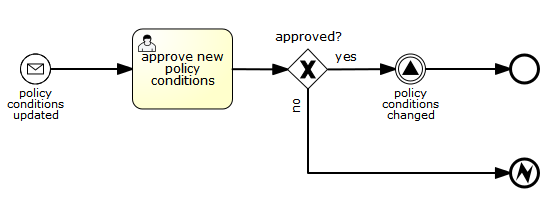
This event can now be caught by all process instances that are interested. The following is an example of a process subscribing to the event.
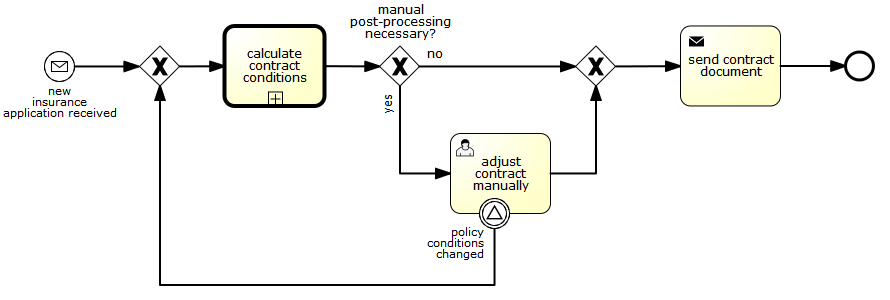
Note: it’s important to understand that a signal event is broadcast to all active handlers. This means, in the case of the example given above, that all instances of the process catching the signal will receive the event. In this scenario, this is what we want. However, there are also situations where the broadcast behavior is unintended. Consider the following process:
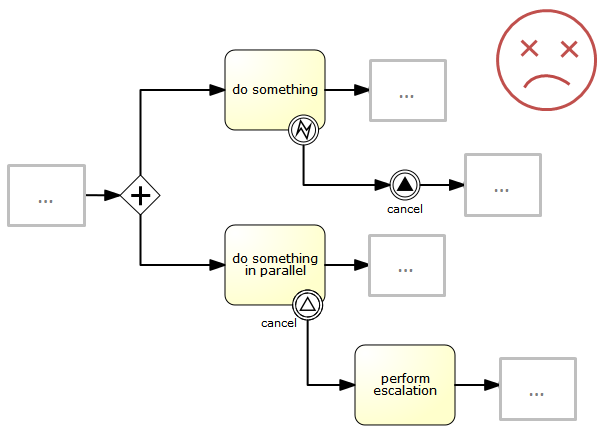
The pattern described in the process above is not supported by BPMN. The idea is that the error thrown while performing the "do something" task is caught by the boundary error event, propagated to the parallel path of execution using the signal throw event and then interrupt the "do something in parallel" task. So far, Flowable would perform as expected. The signal would be propagated to the catching boundary event and interrupt the task. However, due to the broadcast semantics of the signal, it would also be propagated to all other process instances that have subscribed to the signal event. In this case, this might not be what we want.
Note: the signal event does not perform any kind of correlation to a specific process instance. On the contrary, it is broadcast to all process instances. If you need to deliver a signal to a specific process instance only, perform the correlation manually and use signalEventReceived(String signalName, String executionId) along with the appropriate query mechanisms.
Flowable does have a way to fix this by adding the scope attribute to the signal event set to processInstance.
Message Event Definitions
Message events are events that reference a named message. A message has a name and a payload. Unlike a signal, a message event is always directed at a single receiver.
A message event definition is declared using the messageEventDefinition element. The attribute messageRef references a message element declared as a child element of the definitions root element. The following is an excerpt of a process where two message events is declared and referenced by a start event and an intermediate catching message event.
<definitions id="definitions"
xmlns="http://www.omg.org/spec/BPMN/20100524/MODEL"
xmlns:flowable="http://flowable.org/bpmn"
targetNamespace="Examples"
xmlns:tns="Examples">
<message id="newInvoice" name="newInvoiceMessage" />
<message id="payment" name="paymentMessage" />
<process id="invoiceProcess">
<startEvent id="messageStart" >
<messageEventDefinition messageRef="newInvoice" />
</startEvent>
...
<intermediateCatchEvent id="paymentEvt" >
<messageEventDefinition messageRef="payment" />
</intermediateCatchEvent>
...
</process>
</definitions>
Throwing a Message Event
As an embeddable process engine, Flowable is not concerned with actually receiving a message. This would be environment dependent and entail platform-specific activities, such as connecting to a JMS (Java Messaging Service) Queue/Topic or processing a Webservice or REST request. The reception of messages is therefore something you have to implement as part of the application or infrastructure into which the process engine is embedded.
After you have received a message inside your application, you must decide what to do with it. If the message should trigger the start of a new process instance, choose between the following methods offered by the runtime service:
ProcessInstance startProcessInstanceByMessage(String messageName);
ProcessInstance startProcessInstanceByMessage(String messageName, Map<String, Object> processVariables);
ProcessInstance startProcessInstanceByMessage(String messageName, String businessKey,
Map<String, Object> processVariables);
These methods start a process instance using the referenced message.
If the message needs to be received by an existing process instance, you first have to correlate the message to a specific process instance (see next section) and then trigger the continuation of the waiting execution. The runtime service offers the following methods for triggering an execution based on a message event subscription:
void messageEventReceived(String messageName, String executionId);
void messageEventReceived(String messageName, String executionId, HashMap<String, Object> processVariables);
Querying for Message Event subscriptions
- In the case of a message start event, the message event subscription is associated with a particular process definition. Such message subscriptions can be queried using a ProcessDefinitionQuery:
ProcessDefinition processDefinition = repositoryService.createProcessDefinitionQuery()
.messageEventSubscription("newCallCenterBooking")
.singleResult();
Since there can only be one process definition for a specific message subscription, the query always returns zero or one result. If a process definition is updated, only the newest version of the process definition has a subscription to the message event.
- In the case of an intermediate catch message event, the message event subscription is associated with a particular execution. Such message event subscriptions can be queried using a ExecutionQuery:
Execution execution = runtimeService.createExecutionQuery()
.messageEventSubscriptionName("paymentReceived")
.variableValueEquals("orderId", message.getOrderId())
.singleResult();
Such queries are called correlation queries and usually require knowledge about the processes (in this case, that there will be at most one process instance for a given orderId).
Message Event example(s)
The following is an example of a process that can be started using two different messages:
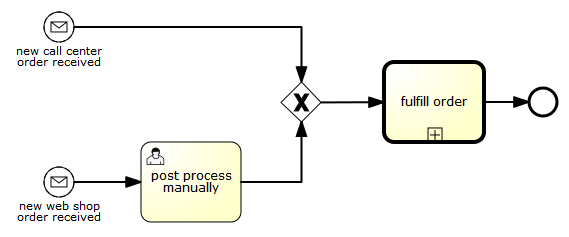
This is useful if the process needs alternative ways to react to different start events, but eventually continues in a uniform way.
Start Events
A start event indicates where a process starts. The type of start event (process starts on arrival of message, on specific time intervals, and so on), defining how the process is started, is shown as a small icon in the visual representation of the event. In the XML representation, the type is given by the declaration of a sub-element.
Start events are always catching: conceptually the event is (at any time) waiting until a certain trigger happens.
In a start event, the following Flowable-specific properties can be specified:
- initiator: identifies the variable name in which the authenticated user ID will be stored when the process is started. For example:
<startEvent id="request" flowable:initiator="initiator" />
The authenticated user must be set with the method IdentityService.setAuthenticatedUserId(String) in a try-finally block, like this:
try {
identityService.setAuthenticatedUserId("bono");
runtimeService.startProcessInstanceByKey("someProcessKey");
} finally {
identityService.setAuthenticatedUserId(null);
}
This code is baked into the Flowable application, so it works in combination with ???.
None Start Event
Description
A 'none' start event technically means that the trigger for starting the process instance is unspecified. This means that the engine cannot anticipate when the process instance must be started. The none start event is used when the process instance is started through the API by calling one of the startProcessInstanceByXXX methods.
ProcessInstance processInstance = runtimeService.startProcessInstanceByXXX();
Note: a sub-process always has a none start event.
Graphical notation
A none start event is visualized as a circle with no inner icon (in other words, no trigger type).
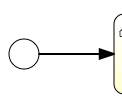
XML representation
The XML representation of a none start event is the normal start event declaration without any sub-element (other start event types all have a sub-element declaring the type).
<startEvent id="start" name="my start event" />
Custom extensions for the none start event
formKey: references a form definition that users have to fill in when starting a new process instance. More information can be found in the forms section Example:
<startEvent id="request" flowable:formKey="request" />
Timer Start Event
Description
A timer start event is used to create process instances at given time. It can be used both for processes that should start only once and for processes that should start in specific time intervals.
Note: a sub-process cannot have a timer start event.
Note: a start timer event is scheduled as soon as process is deployed. There is no need to call startProcessInstanceByXXX, although calling start process methods is not restricted and will cause one more starting of the process at the time of startProcessInstanceByXXX invocation.
Note: when a new version of a process with a start timer event is deployed, the job corresponding with the previous timer will be removed. The reasoning is that normally it is not desirable to keep automatically starting new process instances of the old version of the process.
Graphical notation
A timer start event is visualized as a circle with clock inner icon.

XML representation
The XML representation of a timer start event is the normal start event declaration, with timer definition sub-element. Please refer to timer definitions for configuration details.
Example: process will start 4 times, in 5 minute intervals, starting on 11th march 2011, 12:13
<startEvent id="theStart">
<timerEventDefinition>
<timeCycle>R4/2011-03-11T12:13/PT5M</timeCycle>
</timerEventDefinition>
</startEvent>
Example: process will start once, on selected date
<startEvent id="theStart">
<timerEventDefinition>
<timeDate>2011-03-11T12:13:14</timeDate>
</timerEventDefinition>
</startEvent>
Message Start Event
Description
A message start event can be used to start a process instance using a named message. This effectively allows us to select the right start event from a set of alternative start events using the message name.
When deploying a process definition with one or more message start events, the following considerations apply:
The name of the message start event must be unique across a given process definition. A process definition must not have multiple message start events with the same name. Flowable throws an exception upon deployment of a process definition containing two or more message start events referencing the same message, or if two or more message start events reference messages with the same message name.
The name of the message start event must be unique across all deployed process definitions. Flowable throws an exception upon deployment of a process definition containing one or more message start events referencing a message with the same name as a message start event already deployed by a different process definition.
Process versioning: Upon deployment of a new version of a process definition, the start message subscriptions of the previous version are removed.
When starting a process instance, a message start event can be triggered using the following methods on the RuntimeService:
ProcessInstance startProcessInstanceByMessage(String messageName);
ProcessInstance startProcessInstanceByMessage(String messageName, Map<String, Object> processVariables);
ProcessInstance startProcessInstanceByMessage(String messageName, String businessKey,
Map<String, Object< processVariables);
The messageName is the name given in the name attribute of the message element referenced by the messageRef attribute of the messageEventDefinition. The following considerations apply when starting a process instance:
Message start events are only supported on top-level processes. Message start events are not supported on embedded sub processes.
If a process definition has multiple message start events, runtimeService.startProcessInstanceByMessage(...) allows to select the appropriate start event.
If a process definition has multiple message start events and a single none start event, runtimeService.startProcessInstanceByKey(...) and runtimeService.startProcessInstanceById(...) starts a process instance using the none start event.
If a process definition has multiple message start events and no none start event, runtimeService.startProcessInstanceByKey(...) and runtimeService.startProcessInstanceById(...) throw an exception.
If a process definition has a single message start event, runtimeService.startProcessInstanceByKey(...) and runtimeService.startProcessInstanceById(...) start a new process instance using the message start event.
If a process is started from a call activity, message start event(s) are only supported if
in addition to the message start event(s), the process has a single none start event
the process has a single message start event and no other start events.
Graphical notation
A message start event is visualized as a circle with a message event symbol. The symbol is unfilled, to represent the catching (receiving) behavior.

XML representation
The XML representation of a message start event is the normal start event declaration with a messageEventDefinition child-element:
<definitions id="definitions"
xmlns="http://www.omg.org/spec/BPMN/20100524/MODEL"
xmlns:flowable="http://flowable.org/bpmn"
targetNamespace="Examples"
xmlns:tns="Examples">
<message id="newInvoice" name="newInvoiceMessage" />
<process id="invoiceProcess">
<startEvent id="messageStart" >
<messageEventDefinition messageRef="tns:newInvoice" />
</startEvent>
...
</process>
</definitions>
Signal Start Event
Description
A signal start event can be used to start a process instance using a named signal. The signal can be 'fired' from within a process instance using the intermediary signal throw event or through the API (runtimeService.signalEventReceivedXXX methods). In both cases, all process definitions that have a signal start event with the same name will be started.
Note that in both cases, it is also possible to choose between a synchronous and asynchronous starting of the process instances.
The signalName that must be passed in the API is the name given in the name attribute of the signal element referenced by the signalRef attribute of the signalEventDefinition.
Graphical notation
A signal start event is visualized as a circle with a signal event symbol. The symbol is unfilled, to represent the catching (receiving) behavior.
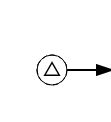
XML representation
The XML representation of a signal start event is the normal start event declaration with a signalEventDefinition child-element:
<signal id="theSignal" name="The Signal" />
<process id="processWithSignalStart1">
<startEvent id="theStart">
<signalEventDefinition id="theSignalEventDefinition" signalRef="theSignal" />
</startEvent>
<sequenceFlow id="flow1" sourceRef="theStart" targetRef="theTask" />
<userTask id="theTask" name="Task in process A" />
<sequenceFlow id="flow2" sourceRef="theTask" targetRef="theEnd" />
<endEvent id="theEnd" />
</process>
Error Start Event
Description
An error start event can be used to trigger an Event Sub-Process. An error start event cannot be used for starting a process instance.
An error start event is always interrupting.
Graphical notation
An error start event is visualized as a circle with an error event symbol. The symbol is unfilled, to represent the catching (receiving) behavior.
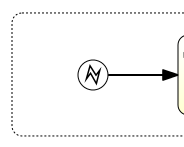
XML representation
The XML representation of an error start event is the normal start event declaration with an errorEventDefinition child-element:
<startEvent id="messageStart" >
<errorEventDefinition errorRef="someError" />
</startEvent>
End Events
An end event signifies the end of a path in a process or sub-process. An end event is always throwing. This means that when process execution arrives at an end event, a result is thrown. The type of result is depicted by the inner black icon of the event. In the XML representation, the type is given by the declaration of a sub-element.
None End Event
Description
A 'none' end event means that the result thrown when the event is reached is unspecified. As such, the engine will not do anything extra besides ending the current path of execution.
Graphical notation
A none end event is visualized as a circle with a thick border with no inner icon (no result type).

XML representation
The XML representation of a none end event is the normal end event declaration, without any sub-element (other end event types all have a sub-element declaring the type).
<endEvent id="end" name="my end event" />
Error End Event
Description
When process execution arrives at an error end event, the current path of execution ends and an error is thrown. This error can caught by a matching intermediate boundary error event. If no matching boundary error event is found, an exception will be thrown.
Graphical notation
An error end event is visualized as a typical end event (circle with thick border), with the error icon inside. The error icon is completely black, to indicate its throwing semantics.
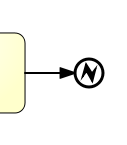
XML representation
An error end event is represented as an end event, with an errorEventDefinition child element.
<endEvent id="myErrorEndEvent">
<errorEventDefinition errorRef="myError" />
</endEvent>
The errorRef attribute can reference an error element that is defined outside the process:
<error id="myError" errorCode="123" />
...
<process id="myProcess">
...
The errorCode of the error will be used to find the matching catching boundary error event. If the errorRef doesn’t match any defined error, then the errorRef is used as a shortcut for the errorCode. This is a Flowable specific shortcut. More concretely, the following snippets are equivalent in functionality.
<error id="myError" errorCode="error123" />
...
<process id="myProcess">
...
<endEvent id="myErrorEndEvent">
<errorEventDefinition errorRef="myError" />
</endEvent>
...
is equivalent with
<endEvent id="myErrorEndEvent">
<errorEventDefinition errorRef="error123" />
</endEvent>
Note that the errorRef must comply with the BPMN 2.0 schema, and must be a valid QName.
Terminate End Event
Description
When a terminate end event is reached, the current process instance or sub-process will be terminated. Conceptually, when an execution arrives at a terminate end event, the first scope (process or sub-process) will be determined and ended. Note that in BPMN 2.0, a sub-process can be an embedded sub-process, call activity, event sub-process or transaction sub-process. This rule applies in general: when, for example, there is a multi-instance call activity or embedded sub-process, only that instance will end, the other instances and the process instance are not affected.
There is an optional attribute terminateAll that can be added. When true, regardless of the placement of the terminate end event in the process definition and regardless of being in a sub-process (even nested), the (root) process instance will be terminated.
Graphical notation
A cancel end event visualized as a typical end event (circle with thick outline), with a full black circle inside.

XML representation
A terminate end event is represented as an end event, with a terminateEventDefinition child element.
Note that the terminateAll attribute is optional (and false by default).
<endEvent id="myEndEvent >
<terminateEventDefinition flowable:terminateAll="true"></terminateEventDefinition>
</endEvent>
Cancel End Event
Description
The cancel end event can only be used in combination with a BPMN transaction sub-process. When the cancel end event is reached, a cancel event is thrown which must be caught by a cancel boundary event. The cancel boundary event then cancels the transaction and triggers compensation.
Graphical notation
A cancel end event is visualized as a typical end event (circle with thick outline), with the cancel icon inside. The cancel icon is completely black, to indicate its throwing semantics.

XML representation
A cancel end event is represented as an end event, with a cancelEventDefinition child element.
<endEvent id="myCancelEndEvent">
<cancelEventDefinition />
</endEvent>
Boundary Events
Boundary events are catching events that are attached to an activity (a boundary event can never be throwing). This means that while the activity is running, the event is listening for a certain type of trigger. When the event is caught, the activity is interrupted and the sequence flow going out of the event is followed.
All boundary events are defined in the same way:
<boundaryEvent id="myBoundaryEvent" attachedToRef="theActivity">
<XXXEventDefinition/>
</boundaryEvent>
A boundary event is defined with
A unique identifier (process-wide)
A reference to the activity to which the event is attached through the attachedToRef attribute. Note that a boundary event is defined on the same level as the activities to which they are attached (in other words, no inclusion of the boundary event inside the activity).
An XML sub-element of the form XXXEventDefinition (for example, TimerEventDefinition, ErrorEventDefinition, and so on) defining the type of the boundary event. See the specific boundary event types for more details.
Timer Boundary Event
Description
A timer boundary event acts as a stopwatch and alarm clock. When an execution arrives at the activity where the boundary event is attached, a timer is started. When the timer fires (for example, after a specified interval), the activity is interrupted and the sequence flow going out of the boundary event is followed.
Graphical Notation
A timer boundary event is visualized as a typical boundary event (circle on the border), with the timer icon on the inside.
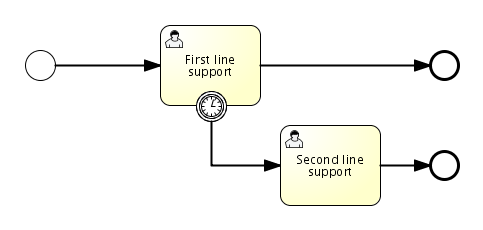
XML Representation
A timer boundary event is defined as a regular boundary event. The specific type sub-element in this case is a timerEventDefinition element.
<boundaryEvent id="escalationTimer" cancelActivity="true" attachedToRef="firstLineSupport">
<timerEventDefinition>
<timeDuration>PT4H</timeDuration>
</timerEventDefinition>
</boundaryEvent>
Please refer to timer event definition for details on timer configuration.
In the graphical representation, the line of the circle is dotted as you can see in the example above:
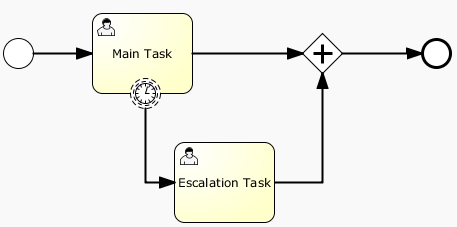
A typical use case is sending an escalation email after a period of time, but without affecting the normal process flow.
There is a key difference between the interrupting and non interrupting timer event. Non-interrupting means the original activity is not interrupted but stays as it was. The interrupting behavior is the default. In the XML representation, the cancelActivity attribute is set to false:
<boundaryEvent id="escalationTimer" cancelActivity="false" attachedToRef="firstLineSupport"/>
Note: boundary timer events are only fired when the async executor is enabled (asyncExecutorActivate needs to be set to true in the flowable.cfg.xml, since the async executor is disabled by default).
Known issue with boundary events
There is a known issue regarding concurrency when using boundary events of any type. Currently, it is not possible to have multiple outgoing sequence flows attached to a boundary event. A solution to this problem is to use one outgoing sequence flow that goes to a parallel gateway.
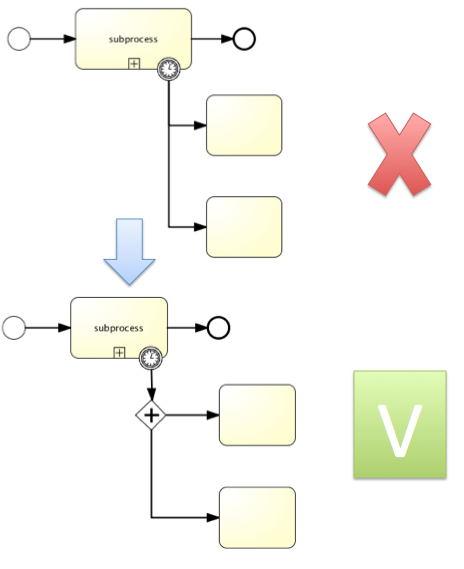
Error Boundary Event
Description
An intermediate catching error on the boundary of an activity, or boundary error event for short, catches errors that are thrown within the scope of the activity on which it is defined.
Defining a boundary error event makes most sense on an embedded sub-process, or a call activity, as a sub-process creates a scope for all activities inside the sub-process. Errors are thrown by error end events. Such an error will propagate its parent scopes upwards until a scope is found on which a boundary error event is defined that matches the error event definition.
When an error event is caught, the activity on which the boundary event is defined is destroyed, also destroying all current executions within (concurrent activities, nested sub-processes, and so on). Process execution continues following the outgoing sequence flow of the boundary event.
Graphical notation
A boundary error event is visualized as a typical intermediate event (circle with smaller circle inside) on the boundary, with the error icon inside. The error icon is white, to indicate its catch semantics.
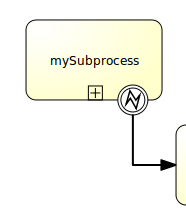
XML representation
A boundary error event is defined as a typical boundary event:
<boundaryEvent id="catchError" attachedToRef="mySubProcess">
<errorEventDefinition errorRef="myError"/>
</boundaryEvent>
As with the error end event, the errorRef references an error defined outside the process element:
<error id="myError" errorCode="123" />
...
<process id="myProcess">
...
The errorCode is used to match the errors that are caught:
If errorRef is omitted, the boundary error event will catch any error event, regardless of the errorCode of the error.
If an errorRef is provided and it references an existing error, the boundary event will only catch errors with the same error code.
If an errorRef is provided, but no error is defined in the BPMN 2.0 file, then the errorRef is used as errorCode (similar for with error end events).
Example
The following example process shows how an error end event can be used. When the 'Review profitability' user task is completed by saying that not enough information is provided, an error is thrown. When this error is caught on the boundary of the sub-process, all active activities within the 'Review sales lead' sub-process are destroyed (even if 'Review customer rating' had not yet been completed), and the 'Provide additional details' user task is created.
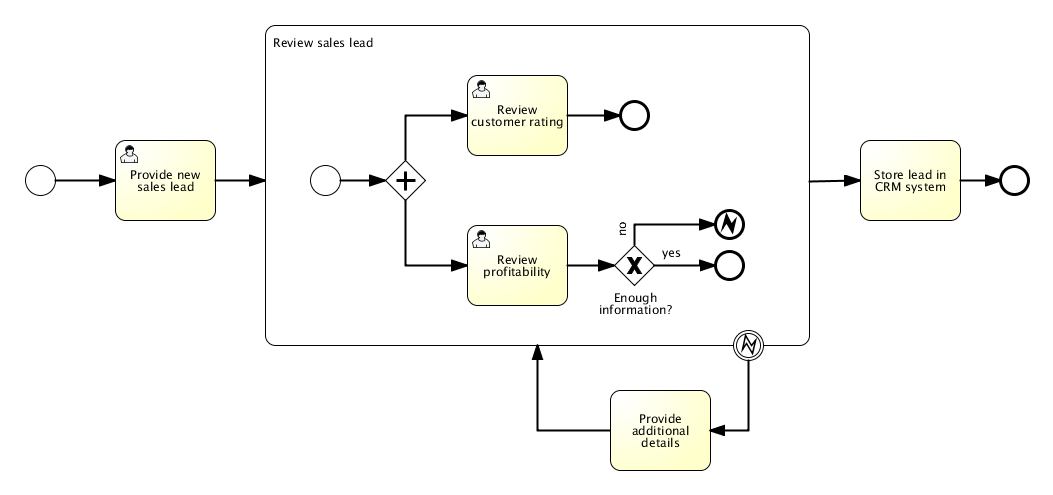
This process is shipped as example in the demo setup. The process XML and unit test can be found in the org.flowable.examples.bpmn.event.error package.
Signal Boundary Event
Description
An attached intermediate catching signal on the boundary of an activity, or boundary signal event for short, catches signals with the same signal name as the referenced signal definition.
Note: contrary to other events, such as the boundary error event, a boundary signal event doesn’t only catch signal events thrown from the scope to which it is attached. On the contrary, a signal event has global scope (broadcast semantics), meaning that the signal can be thrown from any place, even from a different process instance.
Note: contrary to other events, such as the error event, a signal is not consumed if it is caught. If you have two active signal boundary events catching the same signal event, both boundary events are triggered, even if they are part of different process instances.
Graphical notation
A boundary signal event is visualized as a typical intermediate event (circle with smaller circle inside) on the boundary, with the signal icon inside. The signal icon is white (unfilled), to indicate its catch semantics.

XML representation
A boundary signal event is defined as a typical boundary event:
<boundaryEvent id="boundary" attachedToRef="task" cancelActivity="true">
<signalEventDefinition signalRef="alertSignal"/>
</boundaryEvent>
Example
See the section on signal event definitions.
Message Boundary Event
Description
An attached intermediate catching message on the boundary of an activity, or boundary message event for short, catches messages with the same message name as the referenced message definition.
Graphical notation
A boundary message event is visualized as a typical intermediate event (circle with smaller circle inside) on the boundary, with the message icon inside. The message icon is white (unfilled), to indicate its catch semantics.
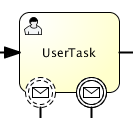
Note that boundary message event can be both interrupting (right-hand side) and non-interrupting (left-hand side).
XML representation
A boundary message event is defined as a typical boundary event:
<boundaryEvent id="boundary" attachedToRef="task" cancelActivity="true">
<messageEventDefinition messageRef="newCustomerMessage"/>
</boundaryEvent>
Example
See the section on message event definitions.
Cancel Boundary Event
Description
An attached intermediate catching cancel event on the boundary of a transaction sub-process, or boundary cancel event for short, is triggered when a transaction is canceled. When the cancel boundary event is triggered, it first interrupts all active executions in the current scope. Next, it starts compensation for all active compensation boundary events in the scope of the transaction. Compensation is performed synchronously, in other words, the boundary event waits before compensation is completed before leaving the transaction. When compensation is completed, the transaction sub-process is left using any sequence flows running out of the cancel boundary event.
Note: Only a single cancel boundary event is allowed for a transaction sub-process.
Note: If the transaction sub-process hosts nested sub-processes, compensation is only triggered for sub-processes that have completed successfully.
Note: If a cancel boundary event is placed on a transaction sub-process with multi instance characteristics, if one instance triggers cancellation, the boundary event cancels all instances.
Graphical notation
A cancel boundary event is visualized as a typical intermediate event (circle with smaller circle inside) on the boundary, with the cancel icon inside. The cancel icon is white (unfilled), to indicate its catching semantics.
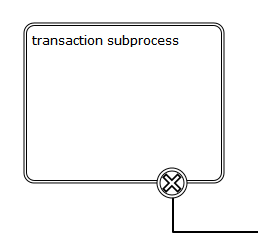
XML representation
A cancel boundary event is defined as a typical boundary event:
<boundaryEvent id="boundary" attachedToRef="transaction" >
<cancelEventDefinition />
</boundaryEvent>
As the cancel boundary event is always interrupting, the cancelActivity attribute is not required.
Compensation Boundary Event
Description
An attached intermediate catching compensation on the boundary of an activity or compensation boundary event for short, can be used to attach a compensation handler to an activity.
The compensation boundary event must reference a single compensation handler using a directed association.
A compensation boundary event has a different activation policy from other boundary events. Other boundary events, such as the signal boundary event, are activated when the activity they are attached to is started. When the activity is finished, they are deactivated and the corresponding event subscription is canceled. The compensation boundary event is different. The compensation boundary event is activated when the activity it is attached to completes successfully. At this point, the corresponding subscription to the compensation events is created. The subscription is removed either when a compensation event is triggered or when the corresponding process instance ends. From this, it follows:
When compensation is triggered, the compensation handler associated with the compensation boundary event is invoked the same number of times the activity it is attached to completed successfully.
If a compensation boundary event is attached to an activity with multiple instance characteristics, a compensation event subscription is created for each instance.
If a compensation boundary event is attached to an activity that is contained inside a loop, a compensation event subscription is created each time the activity is executed.
If the process instance ends, the subscriptions to compensation events are canceled.
Note: the compensation boundary event is not supported on embedded sub-processes.
Graphical notation
A compensation boundary event is visualized as a typical intermediate event (circle with smaller circle inside) on the boundary, with the compensation icon inside. The compensation icon is white (unfilled), to indicate its catching semantics. In addition to a compensation boundary event, the following figure shows a compensation handler associated with the boundary event using a unidirectional association:
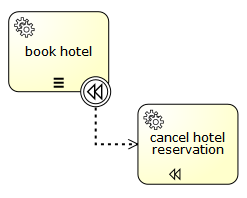
XML representation
A compensation boundary event is defined as a typical boundary event:
<boundaryEvent id="compensateBookHotelEvt" attachedToRef="bookHotel" >
<compensateEventDefinition />
</boundaryEvent>
<association associationDirection="One" id="a1"
sourceRef="compensateBookHotelEvt" targetRef="undoBookHotel" />
<serviceTask id="undoBookHotel" isForCompensation="true" flowable:class="..." />
As the compensation boundary event is activated after the activity has completed successfully, the cancelActivity attribute is not supported.
Intermediate Catching Events
All intermediate catching events are defined in the same way:
<intermediateCatchEvent id="myIntermediateCatchEvent" >
<XXXEventDefinition/>
</intermediateCatchEvent>
An intermediate catching event is defined with:
A unique identifier (process-wide)
An XML sub-element of the form XXXEventDefinition (for example, TimerEventDefinition) defining the type of the intermediate catching event. See the specific catching event types for more details.
Timer Intermediate Catching Event
Description
A timer intermediate event acts as a stopwatch. When an execution arrives at a catching event activity, a timer is started. When the timer fires (for example, after a specified interval), the sequence flow going out of the timer intermediate event is followed.
Graphical Notation
A timer intermediate event is visualized as an intermediate catching event, with the timer icon on the inside.

XML Representation
A timer intermediate event is defined as an intermediate catching event. The specific type sub-element is, in this case, a timerEventDefinition element.
<intermediateCatchEvent id="timer">
<timerEventDefinition>
<timeDuration>PT5M</timeDuration>
</timerEventDefinition>
</intermediateCatchEvent>
See timer event definitions for configuration details.
Signal Intermediate Catching Event
Description
An intermediate catching signal event catches signals with the same signal name as the referenced signal definition.
Note: contrary to other events, such as an error event, a signal is not consumed if it is caught. If you have two active signal boundary events catching the same signal event, both boundary events are triggered, even if they are part of different process instances.
Graphical notation
An intermediate signal catch event is visualized as a typical intermediate event (circle with smaller circle inside), with the signal icon inside. The signal icon is white (unfilled), to indicate its catch semantics.

XML representation
A signal intermediate event is defined as an intermediate catching event. The specific type sub-element is in this case a signalEventDefinition element.
<intermediateCatchEvent id="signal">
<signalEventDefinition signalRef="newCustomerSignal" />
</intermediateCatchEvent>
Example
See the section on signal event definitions.
Message Intermediate Catching Event
Description
An intermediate catching message event catches messages with a specified name.
Graphical notation
An intermediate catching message event is visualized as a typical intermediate event (circle with smaller circle inside), with the message icon inside. The message icon is white (unfilled), to indicate its catch semantics.

XML representation
A message intermediate event is defined as an intermediate catching event. The specific type sub-element is in this case a messageEventDefinition element.
<intermediateCatchEvent id="message">
<messageEventDefinition signalRef="newCustomerMessage" />
</intermediateCatchEvent>
Example
See the section on message event definitions.
Intermediate Throwing Event
All intermediate throwing events are defined in the same way:
<intermediateThrowEvent id="myIntermediateThrowEvent" >
<XXXEventDefinition/>
</intermediateThrowEvent>
An intermediate throwing event is defined with:
A unique identifier (process-wide)
An XML sub-element of the form XXXEventDefinition (for example, signalEventDefinition) defining the type of the intermediate throwing event. See the specific throwing event types for more details.
Intermediate Throwing None Event
The following process diagram shows a simple example of an intermediate none event, which is often used to indicate some state achieved in the process.

This can be a good hook to monitor some KPIs, by adding an execution listener.
<intermediateThrowEvent id="noneEvent">
<extensionElements>
<flowable:executionListener class="org.flowable.engine.test.bpmn.event.IntermediateNoneEventTest$MyExecutionListener" event="start" />
</extensionElements>
</intermediateThrowEvent>
Here you can add some of your own code to maybe send some event to your BAM tool or DWH. The engine itself doesn’t do anything in that case, it just passes through.
Signal Intermediate Throwing Event
Description
An intermediate throwing signal event throws a signal event for a defined signal.
In Flowable, the signal is broadcast to all active handlers (in other words, all catching signal events). Signals can be published synchronously or asynchronously.
In the default configuration, the signal is delivered synchronously. This means that the throwing process instance waits until the signal is delivered to all catching process instances. The catching process instances are also notified in the same transaction as the throwing process instance, which means that if one of the notified instances produces a technical error (throws an exception), all involved instances fail.
A signal can also be delivered asynchronously. In this case it is determined which handlers are active at the time the throwing signal event is reached. For each active handler, an asynchronous notification message (Job) is stored and delivered by the JobExecutor.
Graphical notation
An intermediate signal throw event is visualized as a typical intermediate event (circle with smaller circle inside), with the signal icon inside. The signal icon is black (filled), to indicate its throw semantics.

XML representation
A signal intermediate event is defined as an intermediate throwing event. The specific type sub-element is in this case a signalEventDefinition element.
<intermediateThrowEvent id="signal">
<signalEventDefinition signalRef="newCustomerSignal" />
</intermediateThrowEvent>
An asynchronous signal event would look like this:
<intermediateThrowEvent id="signal">
<signalEventDefinition signalRef="newCustomerSignal" flowable:async="true" />
</intermediateThrowEvent>
Example
See the section on signal event definitions.
Compensation Intermediate Throwing Event
Description
An intermediate throwing compensation event can be used to trigger compensation.
Triggering compensation: Compensation can either be triggered for a designated activity or for the scope that hosts the compensation event. Compensation is performed through execution of the compensation handler associated with an activity.
When compensation is thrown for an activity, the associated compensation handler is executed the same number of times the activity completed successfully.
If compensation is thrown for the current scope, all activities within the current scope are compensated, which includes activities on concurrent branches.
Compensation is triggered hierarchically: if the activity to be compensated is a sub-process, compensation is triggered for all activities contained in the sub-process. If the sub-process has nested activities, compensation is thrown recursively. However, compensation is not propagated to the "upper levels" of the process: if compensation is triggered within a sub-process, it is not propagated to activities outside of the sub-process scope. The BPMN specification states that compensation is triggered for activities at "the same level of sub-process".
In Flowable, compensation is performed in reverse order of execution. This means that whichever activity completed last is compensated first, and so on.
The intermediate throwing compensation event can be used to compensate transaction sub-processes that competed successfully.
Note: If compensation is thrown within a scope that contains a sub-process, and the sub-process contains activities with compensation handlers, compensation is only propagated to the sub-process if it has completed successfully when compensation is thrown. If some of the activities nested inside the sub-process have completed and have attached compensation handlers, the compensation handlers are not executed if the sub-process containing these activities is not completed yet. Consider the following example:
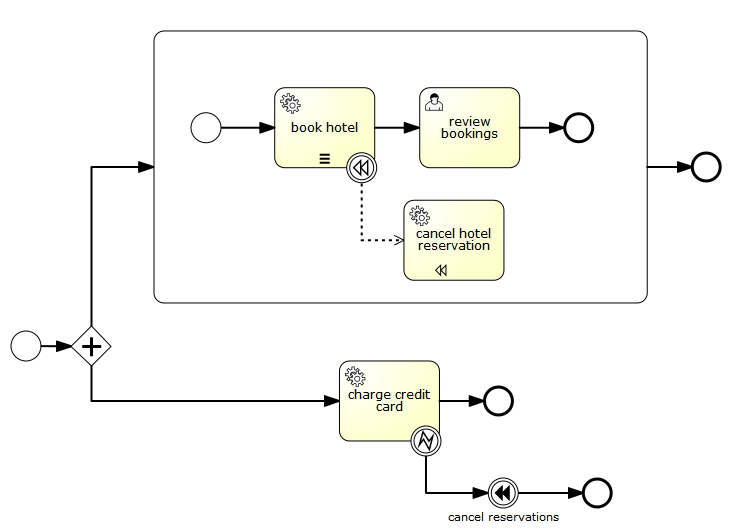
In this process we have two concurrent executions: one executing the embedded sub-process and one executing the "charge credit card" activity. Let’s assume both executions are started and the first concurrent execution is waiting for a user to complete the "review bookings" task. The second execution performs the "charge credit card" activity and an error is thrown, which causes the "cancel reservations" event to trigger compensation. At this point the parallel sub-process is not yet completed which means that the compensation event is not propagated to the sub-process and consequently the "cancel hotel reservation" compensation handler is not executed. If the user task (and therefore the embedded sub-process) completes before the "cancel reservations" is performed, compensation is propagated to the embedded sub-process.
Process variables: When compensating an embedded sub-process, the execution used for executing the compensation handlers has access to the local process variables of the sub-process in the state they were in when the sub-process completed execution. To achieve this, a snapshot of the process variables associated with the scope execution (execution created for executing the sub-process) is taken. From this, a couple of implications follow:
The compensation handler does not have access to variables added to concurrent executions created inside the sub-process scope.
Process variables associated with executions higher up in the hierarchy (for instance, process variables associated with the process instance execution) are not contained in the snapshot: the compensation handler has access to these process variables in the state they are in when compensation is thrown.
A variable snapshot is only taken for embedded sub-processes, not for other activities.
Current limitations:
waitForCompletion="false" is currently unsupported. When compensation is triggered using the intermediate throwing compensation event, the event is only left after compensation completed successfully.
Compensation itself is currently performed by concurrent executions. The concurrent executions are started in reverse order to which the compensated activities completed.
Compensation is not propagated to sub-process instances spawned by call activities.
Graphical notation
An intermediate compensation throw event is visualized as a typical intermediate event (circle with smaller circle inside), with the compensation icon inside. The compensation icon is black (filled), to indicate its throw semantics.

XML representation
A compensation intermediate event is defined as an intermediate throwing event. The specific type sub-element is in this case a compensateEventDefinition element.
<intermediateThrowEvent id="throwCompensation">
<compensateEventDefinition />
</intermediateThrowEvent>
In addition, the optional argument activityRef can be used to trigger compensation of a specific scope or activity:
<intermediateThrowEvent id="throwCompensation">
<compensateEventDefinition activityRef="bookHotel" />
</intermediateThrowEvent>
Sequence Flow
Description
A sequence flow is the connector between two elements of a process. After an element is visited during process execution, all outgoing sequence flows will be followed. This means that the default nature of BPMN 2.0 is to be parallel: two outgoing sequence flows will create two separate, parallel paths of execution.
Graphical notation
A sequence flow is visualized as an arrow going from the source element towards the target element. The arrow always points towards the target.

XML representation
Sequence flows need to have a process-unique id and references to an existing source and target element.
<sequenceFlow id="flow1" sourceRef="theStart" targetRef="theTask" />
Conditional sequence flow
Description
A sequence flow can have a condition defined on it. When a BPMN 2.0 activity is left, the default behavior is to evaluate the conditions on the outgoing sequence flows. When a condition evaluates to true, that outgoing sequence flow is selected. When multiple sequence flows are selected that way, multiple executions will be generated and the process will be continued in a parallel way.
Note: the above holds for BPMN 2.0 activities (and events), but not for gateways. Gateways will handle sequence flows with conditions in specific ways, depending on the gateway type.
Graphical notation
A conditional sequence flow is visualized as a regular sequence flow, with a small diamond at the beginning. The condition expression is shown next to the sequence flow.
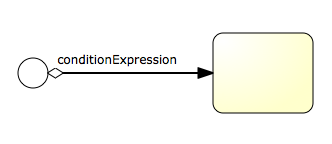
XML representation
A conditional sequence flow is represented in XML as a regular sequence flow, containing a conditionExpression sub-element. Note that currently only tFormalExpressions are supported, Omitting the xsi:type="" definition will simply default to the only supported type of expressions.
<sequenceFlow id="flow" sourceRef="theStart" targetRef="theTask">
<conditionExpression xsi:type="tFormalExpression">
<![CDATA[${order.price > 100 && order.price < 250}]]>
</conditionExpression>
</sequenceFlow>
Currently, conditionalExpressions can only be used with UEL. Detailed information about these can be found in the section on Expressions. The expression used should resolve to a boolean value, otherwise an exception is thrown while evaluating the condition.
- The example below references the data of a process variable, in the typical JavaBean style through getters.
<conditionExpression xsi:type="tFormalExpression">
<![CDATA[${order.price > 100 && order.price < 250}]]>
</conditionExpression>
- This example invokes a method that resolves to a boolean value.
<conditionExpression xsi:type="tFormalExpression">
<![CDATA[${order.isStandardOrder()}]]>
</conditionExpression>
The Flowable distribution contains the following example process using value and method expressions (see org.flowable.examples.bpmn.expression):
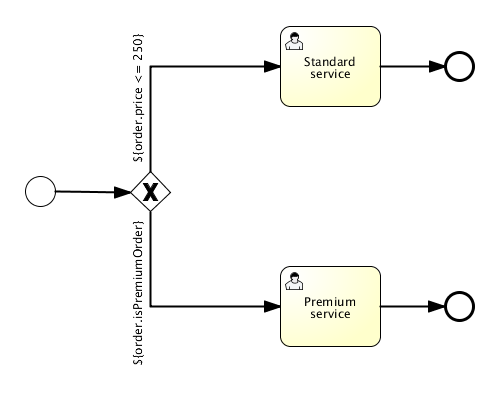
Default sequence flow
Description
All BPMN 2.0 tasks and gateways can have a default sequence flow. This sequence flow is only selected as the outgoing sequence flow for that activity if and only if none of the other sequence flows could be selected. Conditions on a default sequence flow are always ignored.
Graphical notation
A default sequence flow is visualized as a regular sequence flow, with a 'slash' marker at the beginning.

XML representation
A default sequence flow for a certain activity is defined by the default attribute on that activity. The following XML snippet shows an example of an exclusive gateway that has as default sequence flow, flow 2. Only when conditionA and conditionB both evaluate to false, will it be chosen as the outgoing sequence flow for the gateway.
<exclusiveGateway id="exclusiveGw" name="Exclusive Gateway" default="flow2" />
<sequenceFlow id="flow1" sourceRef="exclusiveGw" targetRef="task1">
<conditionExpression xsi:type="tFormalExpression">${conditionA}</conditionExpression>
</sequenceFlow>
<sequenceFlow id="flow2" sourceRef="exclusiveGw" targetRef="task2"/>
<sequenceFlow id="flow3" sourceRef="exclusiveGw" targetRef="task3">
<conditionExpression xsi:type="tFormalExpression">${conditionB}</conditionExpression>
</sequenceFlow>
Which corresponds with the following graphical representation:
Gateways
A gateway is used to control the flow of execution (or as the BPMN 2.0 describes, the tokens of execution). A gateway is capable of consuming or generating tokens.
A gateway is graphically visualized as a diamond shape, with an icon inside. The icon shows the type of gateway.
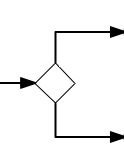
Exclusive Gateway
Description
An exclusive gateway (also called the XOR gateway or more technical the exclusive data-based gateway), is used to model a decision in the process. When the execution arrives at this gateway, all outgoing sequence flows are evaluated in the order in which they are defined. The first sequence flow whose condition evaluates to true (or doesn’t have a condition set, conceptually having a 'true' defined on the sequence flow) is selected for continuing the process.
Note that the semantics of the outgoing sequence flow is different in this case to that of the general case in BPMN 2.0. While, in general, all sequence flows whose condition evaluates to true are selected to continue in a parallel way, only one sequence flow is selected when using the exclusive gateway. If multiple sequence flows have a condition that evaluates to true, the first one defined in the XML (and only that one!) is selected for continuing the process. If no sequence flow can be selected, an exception will be thrown.
Graphical notation
An exclusive gateway is visualized as a typical gateway (a diamond shape) with an 'X' icon inside, referring to the XOR semantics. Note that a gateway without an icon inside defaults to an exclusive gateway. The BPMN 2.0 specification does not permit use of both the diamond with and without an X in the same process definition.

XML representation
The XML representation of an exclusive gateway is straight-forward: one line defining the gateway and condition expressions defined on the outgoing sequence flows. See the section on conditional sequence flow to see which options are available for such expressions.
Take, for example, the following model:
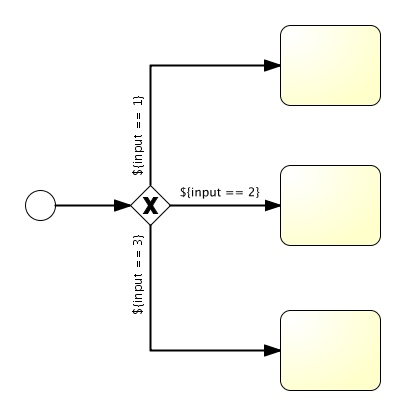
Which is represented in XML as follows:
<exclusiveGateway id="exclusiveGw" name="Exclusive Gateway" />
<sequenceFlow id="flow2" sourceRef="exclusiveGw" targetRef="theTask1">
<conditionExpression xsi:type="tFormalExpression">${input == 1}</conditionExpression>
</sequenceFlow>
<sequenceFlow id="flow3" sourceRef="exclusiveGw" targetRef="theTask2">
<conditionExpression xsi:type="tFormalExpression">${input == 2}</conditionExpression>
</sequenceFlow>
<sequenceFlow id="flow4" sourceRef="exclusiveGw" targetRef="theTask3">
<conditionExpression xsi:type="tFormalExpression">${input == 3}</conditionExpression>
</sequenceFlow>
Parallel Gateway
Description
Gateways can also be used to model concurrency in a process. The most straightforward gateway to introduce concurrency in a process model, is the Parallel Gateway, which allows you to fork into multiple paths of execution or join multiple incoming paths of execution.
The functionality of the parallel gateway is based on the incoming and outgoing sequence flow:
fork: all outgoing sequence flows are followed in parallel, creating one concurrent execution for each sequence flow.
join: all concurrent executions arriving at the parallel gateway wait in the gateway until an execution has arrived for each of the incoming sequence flows. Then the process continues past the joining gateway.
Note that a parallel gateway can have both fork and join behavior, if there are multiple incoming and outgoing sequence flows for the same parallel gateway. In this case, the gateway will first join all incoming sequence flows before splitting into multiple concurrent paths of executions.
An important difference with other gateway types is that the parallel gateway does not evaluate conditions. If conditions are defined on the sequence flows connected with the parallel gateway, they are simply ignored.
Graphical Notation
A parallel gateway is visualized as a gateway (diamond shape) with the 'plus' symbol inside, referring to the 'AND' semantics.

XML representation
Defining a parallel gateway needs one line of XML:
<parallelGateway id="myParallelGateway" />
The actual behavior (fork, join or both), is defined by the sequence flow connected to the parallel gateway.
For example, the model above comes down to the following XML:
<startEvent id="theStart" />
<sequenceFlow id="flow1" sourceRef="theStart" targetRef="fork" />
<parallelGateway id="fork" />
<sequenceFlow sourceRef="fork" targetRef="receivePayment" />
<sequenceFlow sourceRef="fork" targetRef="shipOrder" />
<userTask id="receivePayment" name="Receive Payment" />
<sequenceFlow sourceRef="receivePayment" targetRef="join" />
<userTask id="shipOrder" name="Ship Order" />
<sequenceFlow sourceRef="shipOrder" targetRef="join" />
<parallelGateway id="join" />
<sequenceFlow sourceRef="join" targetRef="archiveOrder" />
<userTask id="archiveOrder" name="Archive Order" />
<sequenceFlow sourceRef="archiveOrder" targetRef="theEnd" />
<endEvent id="theEnd" />
In the example above, after the process is started, two tasks will be created:
ProcessInstance pi = runtimeService.startProcessInstanceByKey("forkJoin");
TaskQuery query = taskService.createTaskQuery()
.processInstanceId(pi.getId())
.orderByTaskName()
.asc();
List<Task> tasks = query.list();
assertEquals(2, tasks.size());
Task task1 = tasks.get(0);
assertEquals("Receive Payment", task1.getName());
Task task2 = tasks.get(1);
assertEquals("Ship Order", task2.getName());
When these two tasks are completed, the second parallel gateway will join the two executions and since there is only one outgoing sequence flow, no concurrent paths of execution will be created, and only the Archive Order task will be active.
Note that a parallel gateway does not need to be 'balanced' (a matching number of incoming/outgoing sequence flow for corresponding parallel gateways). A parallel gateway will simply wait for all incoming sequence flows and create a concurrent path of execution for each outgoing sequence flow, not influenced by other constructs in the process model. So, the following process is legal in BPMN 2.0:

Inclusive Gateway
Description
The Inclusive Gateway can be seen as a combination of an exclusive and a parallel gateway. Like an exclusive gateway you can define conditions on outgoing sequence flows and the inclusive gateway will evaluate them. But the main difference is that the inclusive gateway can take more than one sequence flow, like the parallel gateway.
The functionality of the inclusive gateway is based on the incoming and outgoing sequence flows:
fork: all outgoing sequence flow conditions are evaluated and for the sequence flow conditions that evaluate to true the flows are followed in parallel, creating one concurrent execution for each sequence flow.
join: all concurrent executions arriving at the inclusive gateway wait at the gateway until an execution has arrived for each of the incoming sequence flows that have a process token. This is an important difference with the parallel gateway. So, in other words, the inclusive gateway will only wait for the incoming sequence flows that will be executed. After the join, the process continues past the joining inclusive gateway.
Note that an inclusive gateway can have both fork and join behavior, if there are multiple incoming and outgoing sequence flows for the same inclusive gateway. In this case, the gateway will first join all incoming sequence flows that have a process token, before splitting into multiple concurrent paths of executions for the outgoing sequence flows that have a condition that evaluates to true.
Graphical Notation
An inclusive gateway is visualized as a gateway (diamond shape) with the 'circle' symbol inside.
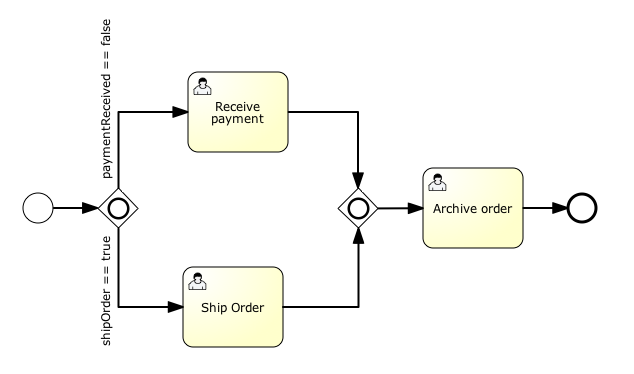
XML representation
Defining an inclusive gateway needs one line of XML:
<inclusiveGateway id="myInclusiveGateway" />
The actual behavior (fork, join or both), is defined by the sequence flows connected to the inclusive gateway.
For example, the model above comes down to the following XML:
<startEvent id="theStart" />
<sequenceFlow id="flow1" sourceRef="theStart" targetRef="fork" />
<inclusiveGateway id="fork" />
<sequenceFlow sourceRef="fork" targetRef="receivePayment" >
<conditionExpression xsi:type="tFormalExpression">${paymentReceived == false}</conditionExpression>
</sequenceFlow>
<sequenceFlow sourceRef="fork" targetRef="shipOrder" >
<conditionExpression xsi:type="tFormalExpression">${shipOrder == true}</conditionExpression>
</sequenceFlow>
<userTask id="receivePayment" name="Receive Payment" />
<sequenceFlow sourceRef="receivePayment" targetRef="join" />
<userTask id="shipOrder" name="Ship Order" />
<sequenceFlow sourceRef="shipOrder" targetRef="join" />
<inclusiveGateway id="join" />
<sequenceFlow sourceRef="join" targetRef="archiveOrder" />
<userTask id="archiveOrder" name="Archive Order" />
<sequenceFlow sourceRef="archiveOrder" targetRef="theEnd" />
<endEvent id="theEnd" />
In the example above, after the process is started, two tasks will be created if the process variables paymentReceived == false and shipOrder == true. If only one of these process variables equals true, only one task will be created. If no condition evaluates to true an exception is thrown. This can be prevented by specifying a default outgoing sequence flow. In the following example one task will be created, the ship order task:
HashMap<String, Object> variableMap = new HashMap<String, Object>();
variableMap.put("receivedPayment", true);
variableMap.put("shipOrder", true);
ProcessInstance pi = runtimeService.startProcessInstanceByKey("forkJoin");
TaskQuery query = taskService.createTaskQuery()
.processInstanceId(pi.getId())
.orderByTaskName()
.asc();
List<Task> tasks = query.list();
assertEquals(1, tasks.size());
Task task = tasks.get(0);
assertEquals("Ship Order", task.getName());
When this task is completed, the second inclusive gateway will join the two executions and as there is only one outgoing sequence flow, no concurrent paths of execution will be created, and only the Archive Order task will be active.
Note that an inclusive gateway does not need to be 'balanced' (a matching number of incoming/outgoing sequence flow for corresponding inclusive gateways). An inclusive gateway will simply wait for all incoming sequence flow and create a concurrent path of execution for each outgoing sequence flow, not influenced by other constructs in the process model.
Event-based Gateway
Description
The Event-based Gateway provides a way to take a decision based on events. Each outgoing sequence flow of the gateway needs to be connected to an intermediate catching event. When process execution reaches an Event-based Gateway, the gateway acts like a wait state: execution is suspended. In addition, for each outgoing sequence flow, an event subscription is created.
Note the sequence flows running out of an Event-based Gateway are different from ordinary sequence flows. These sequence flows are never actually "executed". On the contrary, they allow the process engine to determine which events an execution arriving at an Event-based Gateway needs to subscribe to. The following restrictions apply:
An Event-based Gateway must have two or more outgoing sequence flows.
An Event-based Gateway must only be connected to elements of type intermediateCatchEvent (Receive Tasks after an Event-based Gateway are not supported by Flowable).
An intermediateCatchEvent connected to an Event-based Gateway must have a single incoming sequence flow.
Graphical notation
An Event-based Gateway is visualized as a diamond shape like other BPMN gateways with a special icon inside.

XML representation
The XML element used to define an Event-based Gateway is eventBasedGateway.
Example(s)
The following process is an example of a process with an Event-based Gateway. When the execution arrives at the Event-based Gateway, process execution is suspended. In addition, the process instance subscribes to the alert signal event and creates a timer that fires after 10 minutes. This effectively causes the process engine to wait for ten minutes for a signal event. If the signal occurs within 10 minutes, the timer is cancelled and execution continues after the signal. If the signal is not fired, execution continues after the timer and the signal subscription is canceled.
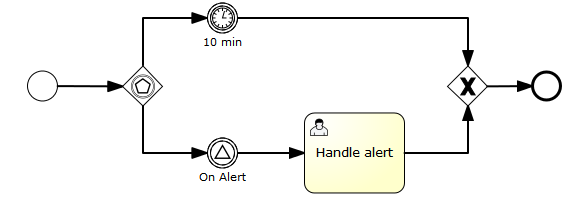
<definitions id="definitions"
xmlns="http://www.omg.org/spec/BPMN/20100524/MODEL"
xmlns:flowable="http://flowable.org/bpmn"
targetNamespace="Examples">
<signal id="alertSignal" name="alert" />
<process id="catchSignal">
<startEvent id="start" />
<sequenceFlow sourceRef="start" targetRef="gw1" />
<eventBasedGateway id="gw1" />
<sequenceFlow sourceRef="gw1" targetRef="signalEvent" />
<sequenceFlow sourceRef="gw1" targetRef="timerEvent" />
<intermediateCatchEvent id="signalEvent" name="Alert">
<signalEventDefinition signalRef="alertSignal" />
</intermediateCatchEvent>
<intermediateCatchEvent id="timerEvent" name="Alert">
<timerEventDefinition>
<timeDuration>PT10M</timeDuration>
</timerEventDefinition>
</intermediateCatchEvent>
<sequenceFlow sourceRef="timerEvent" targetRef="exGw1" />
<sequenceFlow sourceRef="signalEvent" targetRef="task" />
<userTask id="task" name="Handle alert"/>
<exclusiveGateway id="exGw1" />
<sequenceFlow sourceRef="task" targetRef="exGw1" />
<sequenceFlow sourceRef="exGw1" targetRef="end" />
<endEvent id="end" />
</process>
</definitions>
Tasks
User Task
Description
A 'user task' is used to model work that needs to be done by a human. When the process execution arrives at such a user task, a new task is created in the task list of any users or groups assigned to that task.
Graphical notation
A user task is visualized as a typical task (rounded rectangle), with a small user icon in the left upper corner.

XML representation
A user task is defined in XML as follows. The id attribute is required, the name attribute is optional.
<userTask id="theTask" name="Important task" />
A user task can also have a description. In fact, any BPMN 2.0 element can have a description. A description is defined by adding the documentation element.
<userTask id="theTask" name="Schedule meeting" >
<documentation>
Schedule an engineering meeting for next week with the new hire.
</documentation>
The description text can be retrieved from the task in the standard Java way:
task.getDescription()
Due Date
Each task has a field indicating the due date of that task. The Query API can be used to query for tasks that are due on, before or after a given date.
There is an activity extension that allows you to specify an expression in your task-definition to set the initial due date of a task when it is created. The expression should always resolve to a java.util.Date, java.util.String (ISO8601 formatted), ISO8601 time-duration (for example, PT50M) or null. For example, you could use a date that was entered in a previous form in the process or calculated in a previous Service Task. If a time-duration is used, the due-date is calculated based on the current time and incremented by the given period. For example, when "PT30M" is used as dueDate, the task is due in thirty minutes from now.
<userTask id="theTask" name="Important task" flowable:dueDate="${dateVariable}"/>
The due date of a task can also be altered using the TaskService or in TaskListeners using the passed DelegateTask.
User assignment
A user task can be directly assigned to a user. This is done by defining a humanPerformer sub element. Such a humanPerformer definition needs a resourceAssignmentExpression that actually defines the user. Currently, only formalExpressions are supported.
<process >
...
<userTask id='theTask' name='important task' >
<humanPerformer>
<resourceAssignmentExpression>
<formalExpression>kermit</formalExpression>
</resourceAssignmentExpression>
</humanPerformer>
</userTask>
Only one user can be assigned as the human performer for the task. In Flowable terminology, this user is called the assignee. Tasks that have an assignee are not visible in the task lists of other people and can be found in the personal task list of the assignee instead.
Tasks directly assigned to users can be retrieved through the TaskService as follows:
List<Task> tasks = taskService.createTaskQuery().taskAssignee("kermit").list();
Tasks can also be put in the candidate task list of people. In this case, the potentialOwner construct must be used. The usage is similar to the humanPerformer construct. Do note that it is necessary to specify if it is a user or a group defined for each element in the formal expression (the engine cannot guess this).
<process >
...
<userTask id='theTask' name='important task' >
<potentialOwner>
<resourceAssignmentExpression>
<formalExpression>user(kermit), group(management)</formalExpression>
</resourceAssignmentExpression>
</potentialOwner>
</userTask>
Tasks defined with the potential owner construct can be retrieved as follows (or a similar TaskQuery usage as for the tasks with an assignee):
List<Task> tasks = taskService.createTaskQuery().taskCandidateUser("kermit");
This will retrieve all tasks where kermit is a candidate user, in other words, the formal expression contains user(kermit). This will also retrieve all tasks that are assigned to a group of which kermit is a member (for example, group(management), if kermit is a member of that group and the Flowable identity component is used). The user’s groups are resolved at runtime and these can be managed through the IdentityService.
If no specifics are given as to whether the given text string is a user or group, the engine defaults to group. The following would be the same as when group(accountancy) was declared.
<formalExpression>accountancy</formalExpression>
Flowable extensions for task assignment
It is clear that user and group assignments are quite cumbersome for use cases where the assignment is not complex. To avoid these complexities, custom extensions on the user task are possible.
- assignee attribute: this custom extension allows direct assignment of a given user to a task.
<userTask id="theTask" name="my task" flowable:assignee="kermit" />
This is exactly the same as using a humanPerformer construct as defined above.
- candidateUsers attribute: this custom extension makes a given user a candidate for a task.
<userTask id="theTask" name="my task" flowable:candidateUsers="kermit, gonzo" />
This is exactly the same as using the potentialOwner construct as defined above. Note that it is not necessary to use the user(kermit) declaration, as with the case of the potential owner construct, since the attribute can only be used for users.
- candidateGroups attribute: this custom extension makes a given group a candidate for a task.
<userTask id="theTask" name="my task" flowable:candidateGroups="management, accountancy" />
This is exactly the same as using a potentialOwner construct as defined above. Note that it is not necessary to use the group(management) declaration, as with the case of the potential owner construct, since the attribute can only be used for groups.
- candidateUsers and candidateGroups can both be defined on the same user task.
Note: Although Flowable provides an identity management component, which is exposed through the IdentityService, no check is made whether a provided user is known by the identity component. This is to allow Flowable to integrate with existing identity management solutions when it is embedded in an application.
Custom identity link types
The BPMN standard supports a single assigned user or humanPerformer or a set of users that form a potential pool of potentialOwners, as defined in User assignment. In addition, Flowable defines extension attribute elements for the User Task that can represent the task assignee or candidate owner.
The supported Flowable identity link types are:
public class IdentityLinkType {
/* Flowable native roles */
public static final String ASSIGNEE = "assignee";
public static final String CANDIDATE = "candidate";
public static final String OWNER = "owner";
public static final String STARTER = "starter";
public static final String PARTICIPANT = "participant";
}
The BPMN standard and Flowable example authorization identities are user and group. As mentioned in the previous section, the Flowable identity management implementation is not intended for production use, but should be extended depending on the supported authorization scheme.
If additional link types are required, custom resources can be defined as extension elements with the following syntax:
<userTask id="theTask" name="make profit">
<extensionElements>
<flowable:customResource flowable:name="businessAdministrator">
<resourceAssignmentExpression>
<formalExpression>user(kermit), group(management)</formalExpression>
</resourceAssignmentExpression>
</flowable:customResource>
</extensionElements>
</userTask>
The custom link expressions are added to the TaskDefinition class:
protected Map<String, Set<Expression>> customUserIdentityLinkExpressions =
new HashMap<String, Set<Expression>>();
protected Map<String, Set<Expression>> customGroupIdentityLinkExpressions =
new HashMap<String, Set<Expression>>();
public Map<String, Set<Expression>> getCustomUserIdentityLinkExpressions() {
return customUserIdentityLinkExpressions;
}
public void addCustomUserIdentityLinkExpression(
String identityLinkType, Set<Expression> idList) {
customUserIdentityLinkExpressions.put(identityLinkType, idList);
}
public Map<String, Set<Expression>> getCustomGroupIdentityLinkExpressions() {
return customGroupIdentityLinkExpressions;
}
public void addCustomGroupIdentityLinkExpression(
String identityLinkType, Set<Expression> idList) {
customGroupIdentityLinkExpressions.put(identityLinkType, idList);
}
These are populated at runtime by the UserTaskActivityBehavior handleAssignments method.
Finally, the IdentityLinkType class must be extended to support the custom identity link types:
package com.yourco.engine.task;
public class IdentityLinkType extends org.flowable.engine.task.IdentityLinkType {
public static final String ADMINISTRATOR = "administrator";
public static final String EXCLUDED_OWNER = "excludedOwner";
}
Custom Assignment via task listeners
If the previous approaches are not sufficient, it is possible to delegate to custom assignment logic using a task listener on the create event:
<userTask id="task1" name="My task" >
<extensionElements>
<flowable:taskListener event="create" class="org.flowable.MyAssignmentHandler" />
</extensionElements>
</userTask>
The DelegateTask that is passed to the TaskListener implementation can set the assignee and candidate-users/groups:
public class MyAssignmentHandler implements TaskListener {
public void notify(DelegateTask delegateTask) {
// Execute custom identity lookups here
// and then for example call following methods:
delegateTask.setAssignee("kermit");
delegateTask.addCandidateUser("fozzie");
delegateTask.addCandidateGroup("management");
...
}
}
When using Spring, it is possible to use the custom assignment attributes as described in the section above, and delegate to a Spring bean using a task listener with an expression that listens to task create events. In the following example, the assignee will be set by calling the findManagerOfEmployee on the ldapService Spring bean. The emp parameter that is passed, is a process variable>.
<userTask id="task" name="My Task" flowable:assignee="${ldapService.findManagerForEmployee(emp)}"/>
This also works similarly for candidate users and groups:
<userTask id="task" name="My Task" flowable:candidateUsers="${ldapService.findAllSales()}"/>
Note that this will only work if the return type of the invoked method is String or Collection<String> (for candidate users and groups):
public class FakeLdapService {
public String findManagerForEmployee(String employee) {
return "Kermit The Frog";
}
public List<String> findAllSales() {
return Arrays.asList("kermit", "gonzo", "fozzie");
}
}
Script Task
Description
A script task is an automatic activity. When a process execution arrives at the script task, the corresponding script is executed.
Properties:
name: task attribute to indicate the name of the task
type: task attribute whose value must be "script" to indicate the type of task
scriptFormat: extended attribute that indicate the language of the script (for example, javascript, groovy)
script: the script to execute, defined as a string in a field element named "script"
autoStoreVariables: optional task attribute flag (default: false) that indicates whether or not variables defined in the script will be stored in the Execution context (see note below)
resultVariableName: optional task attribute that when present will store a variable with the specified name in the Execution context with the script evaluation result (see note below)
Graphical Notation
A script task is visualized as a typical BPMN 2.0 task (rounded rectangle), with a small 'script' icon in the top-left corner of the rectangle.
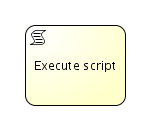
XML representation
A script task is defined by specifying the script and the scriptFormat.
<scriptTask id="theScriptTask" name="Execute script" scriptFormat="groovy">
<script>
sum = 0
for ( i in inputArray ) {
sum += i
}
</script>
</scriptTask>
The value of the scriptFormat attribute must be a name that is compatible with the JSR-223 (scripting for the Java platform). By default, JavaScript is included in every JDK and as such doesn’t need any additional JAR files. If you want to use another (JSR-223 compatible) scripting engine, it is sufficient to add the corresponding JAR to the classpath and use the appropriate name. For example, the Flowable unit tests often use Groovy because the syntax is similar to that of Java.
Do note that the Groovy scripting engine is bundled with the groovy-jsr223 jar. As such, one must add the following dependency:
<dependency>
<groupId>org.apache.groovy</groupId>
<artifactId>groovy-jsr223</artifactId>
<version>4.x.x<version>
</dependency>
Variables in scripts
All process variables that are accessible through the execution that arrives in the script task can be used within the script. In the example, the script variable 'inputArray' is in fact a process variable (an array of integers).
<script>
sum = 0
for ( i in inputArray ) {
sum += i
}
</script>
It’s also possible to set process variables in a script, simply by calling execution.setVariable("variableName", variableValue). By default, no variables are stored automatically (Note: in some older releases this was the case!). It’s possible to automatically store any variable defined in the script (for example, sum in the example above) by setting the property autoStoreVariables on the scriptTask to true. However, the best practice is not to do this and use an explicit execution.setVariable() call, as with some recent versions of the JDK, auto storing of variables does not work for some scripting languages. See this link for more details.
<scriptTask id="script" scriptFormat="JavaScript" flowable:autoStoreVariables="false">
The default for this parameter is false, meaning that if the parameter is omitted from the script task definition, all the declared variables will only exist during the duration of the script.
Here’s an example of how to set a variable in a script:
<script>
def scriptVar = "test123"
execution.setVariable("myVar", scriptVar)
</script>
Note: the following names are reserved and cannot be used as variable names: out, out:print, lang:import, context, elcontext.
Script results
The return value of a script task can be assigned to an already existing, or to a new process variable, by specifying the process variable name as a literal value for the 'flowable:resultVariable' attribute of a script task definition. Any existing value for a specific process variable will be overwritten by the result value of the script execution. When a result variable name is not specified, the script result value gets ignored.
<scriptTask id="theScriptTask" name="Execute script" scriptFormat="juel" flowable:resultVariable="myVar">
<script>#{echo}</script>
</scriptTask>
In the above example, the result of the script execution (the value of the resolved expression '#{echo}') is set to the process variable named 'myVar' after the script completes.
Security
It is also possible when using javascript as the scripting language to use 'secure scripting'. See the secure scripting section.
Java Service Task
Description
A Java service task is used to invoke an external Java class.
Graphical Notation
A service task is visualized as a rounded rectangle with a small gear icon in the top-left corner.
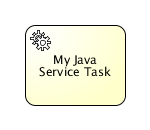
XML representation
There are four ways of declaring how to invoke Java logic:
Specifying a class that implements JavaDelegate, FutureJavaDelegate or ActivityBehavior
Evaluating an expression that resolves to a delegation object
Invoking a method expression
Evaluating a value expression
To specify a class that is called during process execution, the fully qualified classname needs to be provided by the 'flowable:class' attribute.
<serviceTask id="javaService"
name="My Java Service Task"
flowable:class="org.flowable.MyJavaDelegate" />
See the implementation section for more details on how to use such a class.
It’s also possible to use an expression that resolves to an object. This object must follow the same rules as objects that are created when the flowable:class attribute is used (see further).
<serviceTask id="serviceTask" flowable:delegateExpression="${delegateExpressionBean}" />
Here, the delegateExpressionBean is a bean that implements the JavaDelegate or FutureJavaDelegate interface, defined in, for example, the Spring container.
To specify a UEL method expression that should be evaluated, use the attribute flowable:expression.
<serviceTask id="javaService"
name="My Java Service Task"
flowable:expression="#{printer.printMessage()}" />
Method printMessage (without parameters) will be called on the named object named printer.
It’s also possible to pass parameters with a method used in the expression.
<serviceTask id="javaService"
name="My Java Service Task"
flowable:expression="#{printer.printMessage(execution, myVar)}" />
Method printMessage will be called on the object named printer. The first parameter passed is the DelegateExecution, which is available in the expression context, by default, available as execution. The second parameter passed is the value of the variable with name myVar in the current execution.
Note: When the execution of the method defined in flowable:expression takes longer time to execute it is possible to return a CompletableFuture<?>.
When this is used then other parallel flows can be executed in the same time.
To specify a UEL value expression that should be evaluated, use the attribute flowable:expression.
<serviceTask id="javaService"
name="My Java Service Task"
flowable:expression="#{split.ready}" />
The getter method of property ready, getReady (without parameters), will be called on the named bean called split. The named objects are resolved in the execution’s process variables and (if applicable) in the Spring context.
Implementation
To implement a class that can be called during process execution, the class needs to implement the org.flowable.engine.delegate.JavaDelegate interface and provide the required logic in the execute method. When process execution arrives at this particular step, it will execute the logic defined in that method and leave the activity in the default BPMN 2.0 way.
Let’s create, for example, a Java class that can be used to change a process variable String to uppercase. This class needs to implement the org.flowable.engine.delegate.JavaDelegate interface, which requires us to implement the execute(DelegateExecution) method. It’s this operation that will be called by the engine and which needs to contain the business logic. Process instance information, such as process variables, can be accessed and manipulated through the DelegateExecution interface (click on the link for a detailed Javadoc of its operations).
public class ToUppercase implements JavaDelegate {
public void execute(DelegateExecution execution) {
String var = (String) execution.getVariable("input");
var = var.toUpperCase();
execution.setVariable("input", var);
}
}
Note: there will be only one instance of the Java class created for the serviceTask on which it is defined. All process instances share the same class instance that will be used to call execute(DelegateExecution). This means that the class must not use any member variables and must be thread-safe, as it can be executed simultaneously from different threads. This also influences the way Field injection is handled.
The classes that are referenced in the process definition (by using flowable:class) are NOT instantiated during deployment. Only when a process execution arrives for the first time at the point in the process where the class is used, an instance of that class will be created. If the class cannot be found, an FlowableException will be thrown. The reasoning for this is that the environment (and more specifically, the classpath) when you are deploying is often different from the actual runtime environment. For example, when using ant or the business archive upload in the Flowable app to deploy processes, the classpath will not automatically contain the referenced classes.
In case the execution takes longer it is possible to delegate that work on a different thread, but still continue executing parallel activities.
In order to do this the org.flowable.engine.delegate.FutureJavaDelegate needs to be implemented.
This is a more advanced interface and special care needs to be done in order for data to be set on the DelegateExecution and to take care about the transaction boundaries.
public class LongRunningJavaDelegate implements FutureJavaDelegate<String> {
public CompletableFuture<String> execute(DelegateExecution execution, AsyncTaskInvoker taskInvoker) {
// This is running in the same transaction as the process instance and is still possible to set and extract data from the execution
String input = (String) execution.getVariable("input");
// The taskInvoker is a common invoker provided by Flowable that can be used to submit complex executions on a new thread.
// However, you don't have to use it, you can use your own custom ExecutorService or return a CompletableFuture from your own services.
return taskInvoker.submit(() -> {
// This is running on a new thread. The execution shouldn't be used here.
// There is also no transaction here. In case a new transaction is needed, then it should be managed by your own services
// Perform some complex logic that takes some time, e.g. invoking an external service
return "done";
});
}
public void afterExecution(DelegateExecution execution, String executionData) {
// This is running in the same transaction and thread as the process instance and data can be set on the execution
execution.setVariable("longRunningResult", executionData);
}
}
There are also 2 other interfaces that can be used in to simplify your own implementation:
- org.flowable.engine.delegate.FlowableFutureJavaDelegate, in which the default (or configured) AsyncTaskInvoker will be used, simplifying the logic.
- org.flowable.engine.delegate.MapBasedFlowableFutureJavaDelegate, which simplifies the passing of input and output further by using a ReadOnlyDelegateExecution and a Map respectively.
The same implementation with the other interfaces looks like:
public class LongRunningJavaDelegate implements FlowableFutureJavaDelegate<String, String> {
public String prepareExecutionData(DelegateExecution execution) {
// This is running in the same transaction and thread as the process instance.
// The execution can be used
return execution.getVariable("input");
}
public String execute(String inputData) {
// This is running on a new thread. The execution shouldn't be used here.
// There is also no transaction here. In case a new transaction is needed, then it should be managed by your own services
// Perform some complex logic that takes some time, e.g. invoking an external service
return "done";
}
public void afterExecution(DelegateExecution execution, String executionData) {
// This is running in the same transaction and thread as the process instance and data can be set on the execution
execution.setVariable("longRunningResult", executionData);
}
}
public class LongRunningJavaDelegate implements MapBasedFlowableFutureJavaDelegate {
public Map<String, Object> execute(ReadOnlyDelegateExecution execution) {
// The execution is a read only snapshot of the delegate execution
// This is running on a new thread. The execution shouldn't be used here.
// There is also no transaction here. In case a new transaction is needed, then it should be managed by your own services
// Perform some complex logic that takes some time, e.g. invoking an external service
Map<String, Object> result = new HashMap<>();
result.put("longRunningResult", "done");
// All the values from the returned map will be set on the execution
return result;
}
}
Note: the same rules and logic that applied for the JavaDelegate applies for the FutureJavaDelegate as well.
Keep in mind that when using field expression inject the evaluation of the expression should only be done before or after the execution is done (on the same thread as the process instance).
[INTERNAL: non-public implementation classes] It is also possible to provide a class that implements the org.flowable.engine.impl.delegate.ActivityBehavior interface. Implementations then have access to more powerful engine functionality, for example, to influence the control flow of the process. Note however that this is not a very good practice and should be avoided as much as possible. So, it is advisable to use the ActivityBehavior interface only for advanced use cases and if you know exactly what you’re doing.
Field Injection
It’s possible to inject values into the fields of the delegated classes. The following types of injection are supported:
Fixed string values
Expressions
If available, the value is injected through a public setter method on your delegated class, following the Java Bean naming conventions (for example, field firstName has setter setFirstName(...)). If no setter is available for that field, the value of the private member will be set on the delegate. SecurityManagers in some environments don’t allow modification of private fields, so it’s safer to expose a public setter-method for the fields you want to have injected.
Regardless of the type of value declared in the process-definition, the type of the setter/private field on the injection target should always be org.flowable.engine.delegate.Expression. When the expression is resolved, it can be cast to the appropriate type.
Field injection is supported when using the 'flowable:class' attribute. Field injection is also possible when using the flowable:delegateExpression attribute, however special rules with regards to thread-safety apply (see next section).
The following code snippet shows how to inject a constant value into a field declared on the class. Note that we need to declare an 'extensionElements' XML element before the actual field injection declarations, which is a requirement of the BPMN 2.0 XML Schema.
<serviceTask id="javaService"
name="Java service invocation"
flowable:class="org.flowable.examples.bpmn.servicetask.ToUpperCaseFieldInjected">
<extensionElements>
<flowable:field name="text" stringValue="Hello World" />
</extensionElements>
</serviceTask>
The class ToUpperCaseFieldInjected has a field text that is of type org.flowable.engine.delegate.Expression. When calling text.getValue(execution), the configured string value Hello World will be returned:
public class ToUpperCaseFieldInjected implements JavaDelegate {
private Expression text;
public void execute(DelegateExecution execution) {
execution.setVariable("var", ((String)text.getValue(execution)).toUpperCase());
}
}
Alternatively, for long texts (for example, an inline e-mail) the 'flowable:string' sub element can be used:
<serviceTask id="javaService"
name="Java service invocation"
flowable:class="org.flowable.examples.bpmn.servicetask.ToUpperCaseFieldInjected">
<extensionElements>
<flowable:field name="text">
<flowable:string>
This is a long string with a lot of words and potentially way longer even!
</flowable:string>
</flowable:field>
</extensionElements>
</serviceTask>
To inject values that are dynamically resolved at runtime, expressions can be used. Those expressions can use process variables or Spring defined beans (if Spring is used). As noted in Service Task Implementation, an instance of the Java class is shared among all process-instances in a service task when using the flowable:class attribute. To have dynamic injection of values in fields, you can inject value and method expressions in a org.flowable.engine.delegate.Expression that can be evaluated/invoked using the DelegateExecution passed in the execute method.
The example class below uses the injected expressions and resolves them using the current DelegateExecution. A genderBean method call is used while passing the gender variable. Full code and test can be found in org.flowable.examples.bpmn.servicetask.JavaServiceTaskTest.testExpressionFieldInjection
<serviceTask id="javaService" name="Java service invocation"
flowable:class="org.flowable.examples.bpmn.servicetask.ReverseStringsFieldInjected">
<extensionElements>
<flowable:field name="text1">
<flowable:expression>${genderBean.getGenderString(gender)}</flowable:expression>
</flowable:field>
<flowable:field name="text2">
<flowable:expression>Hello ${gender == 'male' ? 'Mr.' : 'Mrs.'} ${name}</flowable:expression>
</flowable:field>
</ extensionElements>
</ serviceTask>
public class ReverseStringsFieldInjected implements JavaDelegate {
private Expression text1;
private Expression text2;
public void execute(DelegateExecution execution) {
String value1 = (String) text1.getValue(execution);
execution.setVariable("var1", new StringBuffer(value1).reverse().toString());
String value2 = (String) text2.getValue(execution);
execution.setVariable("var2", new StringBuffer(value2).reverse().toString());
}
}
Alternatively, you can also set the expressions as an attribute instead of a child-element, to make the XML less verbose.
<flowable:field name="text1" expression="${genderBean.getGenderString(gender)}" />
<flowable:field name="text1" expression="Hello ${gender == 'male' ? 'Mr.' : 'Mrs.'} ${name}" />
Field injection and thread safety
In general, using service tasks with Java delegates and field injections are thread-safe. However, there are a few situations where thread-safety is not guaranteed, depending on the setup or environment Flowable is running in.
With the flowable:class attribute, using field injection is always thread safe. For each service task that references a certain class, a new instance will be instantiated and fields will be injected once when the instance is created. Reusing the same class multiple times in different tasks or process definitions is no problem.
When using the flowable:expression attribute, use of field injection is not possible. Parameters are passed via method calls and these are always thread-safe.
When using the flowable:delegateExpression attribute, the thread-safety of the delegate instance will depend on how the expression is resolved. If the delegate expression is reused in various tasks or process definitions, and the expression always returns the same instance, using field injection is not thread-safe. Let’s look at a few examples to clarify.
Suppose the expression is ${factory.createDelegate(someVariable)}, where factory is a Java bean known to the engine (for example, a Spring bean when using the Spring integration) that creates a new instance each time the expression is resolved. When using field injection in this case, there is no problem with regards to thread-safety: each time the expression is resolved, the fields are injected in this new instance.
However, suppose the expression is ${someJavaDelegateBean} that resolves to an implementation of the JavaDelegate class and we’re running in an environment that creates singleton instances of each bean (such as Spring, but many others too). When using this expression in different tasks or process definitions, the expression will always be resolved to the same instance. In this case, using field injection is not thread-safe. For example:
<serviceTask id="serviceTask1" flowable:delegateExpression="${someJavaDelegateBean}">
<extensionElements>
<flowable:field name="someField" expression="${input * 2}"/>
</extensionElements>
</serviceTask>
<!-- other process definition elements -->
<serviceTask id="serviceTask2" flowable:delegateExpression="${someJavaDelegateBean}">
<extensionElements>
<flowable:field name="someField" expression="${input * 2000}"/>
</extensionElements>
</serviceTask>
This example snippet has two service tasks that use the same delegate expression, but inject different values for the Expression field. If the expression resolves to the same instance, there can be race conditions in concurrent scenarios when it comes to injecting the field someField when the processes are executed.
The easiest solution to solve this is to either:
rewrite the Java delegate to use an expression and passing the required data to the delegate via a method arguments.
return a new instance of the delegate class each time the delegate expression is resolved. For example, when using Spring, this means that the scope of the bean must be set to prototype (such as by adding the @Scope(SCOPE_PROTOTYPE) annotation to the delegate class).
As of Flowable v5.22, the process engine configuration can be set in a way to disable the use of field injection on delegate expressions, by setting the value of the delegateExpressionFieldInjectionMode property (which takes one of the values in the org.flowable.engine.imp.cfg.DelegateExpressionFieldInjectionMode enum).
Following settings are possible:
DISABLED : fully disables field injection when using delegate expressions. No field injection will be attempted. This is the safest mode when it comes to thread-safety.
COMPATIBILITY: in this mode, the behavior will be exactly as it was before v5.21: field injection is possible when using delegate expressions and an exception will be thrown when the fields are not defined on the delegate class. This is, of course, the least safe mode with regards to thread-safety, but it can be necessary for backwards compatibility or can be used safely when the delegate expression is used only on one task in a set of process definitions (and thus no concurrent race conditions can happen).
MIXED: Allows injection when using delegateExpressions, but will not throw an exception when the fields are not defined on the delegate. This allows for mixed behaviors, where some delegates have injection (for example, because they are not singletons) and some don’t.
The default mode for Flowable version 5.x is COMPATIBILITY.
The default mode for Flowable version 6.x is MIXED.
As an example, suppose that we’re using MIXED mode and we’re using Spring integration. Suppose that we have the following beans in the Spring configuration:
<bean id="singletonDelegateExpressionBean"
class="org.flowable.spring.test.fieldinjection.SingletonDelegateExpressionBean" />
<bean id="prototypeDelegateExpressionBean"
class="org.flowable.spring.test.fieldinjection.PrototypeDelegateExpressionBean"
scope="prototype" />
The first bean is a regular Spring bean and thus a singleton. The second one has prototype as scope, and the Spring container will return a new instance every time the bean is requested.
Given the following process definition:
<serviceTask id="serviceTask1" flowable:delegateExpression="${prototypeDelegateExpressionBean}">
<extensionElements>
<flowable:field name="fieldA" expression="${input * 2}"/>
<flowable:field name="fieldB" expression="${1 + 1}"/>
<flowable:field name="resultVariableName" stringValue="resultServiceTask1"/>
</extensionElements>
</serviceTask>
<serviceTask id="serviceTask2" flowable:delegateExpression="${prototypeDelegateExpressionBean}">
<extensionElements>
<flowable:field name="fieldA" expression="${123}"/>
<flowable:field name="fieldB" expression="${456}"/>
<flowable:field name="resultVariableName" stringValue="resultServiceTask2"/>
</extensionElements>
</serviceTask>
<serviceTask id="serviceTask3" flowable:delegateExpression="${singletonDelegateExpressionBean}">
<extensionElements>
<flowable:field name="fieldA" expression="${input * 2}"/>
<flowable:field name="fieldB" expression="${1 + 1}"/>
<flowable:field name="resultVariableName" stringValue="resultServiceTask1"/>
</extensionElements>
</serviceTask>
<serviceTask id="serviceTask4" flowable:delegateExpression="${singletonDelegateExpressionBean}">
<extensionElements>
<flowable:field name="fieldA" expression="${123}"/>
<flowable:field name="fieldB" expression="${456}"/>
<flowable:field name="resultVariableName" stringValue="resultServiceTask2"/>
</extensionElements>
</serviceTask>
We’ve got four service tasks, where the first and the second use the ${prototypeDelegateExpressionBean} delegate expression and the third and fourth use the ${singletonDelegateExpressionBean} delegate expression.
Let’s look at the prototype bean first:
public class PrototypeDelegateExpressionBean implements JavaDelegate {
public static AtomicInteger INSTANCE_COUNT = new AtomicInteger(0);
private Expression fieldA;
private Expression fieldB;
private Expression resultVariableName;
public PrototypeDelegateExpressionBean() {
INSTANCE_COUNT.incrementAndGet();
}
@Override
public void execute(DelegateExecution execution) {
Number fieldAValue = (Number) fieldA.getValue(execution);
Number fieldValueB = (Number) fieldB.getValue(execution);
int result = fieldAValue.intValue() + fieldValueB.intValue();
execution.setVariable(resultVariableName.getValue(execution).toString(), result);
}
}
When we check the INSTANCE_COUNT after running a process instance of the process definition above, we’ll get two back, as a new instance is created every time ${prototypeDelegateExpressionBean} is resolved. Fields can be injected without any problem here and we can see the three Expression member fields here.
The singleton bean, however, looks slightly different:
public class SingletonDelegateExpressionBean implements JavaDelegate {
public static AtomicInteger INSTANCE_COUNT = new AtomicInteger(0);
public SingletonDelegateExpressionBean() {
INSTANCE_COUNT.incrementAndGet();
}
@Override
public void execute(DelegateExecution execution) {
Expression fieldAExpression = DelegateHelper.getFieldExpression(execution, "fieldA");
Number fieldA = (Number) fieldAExpression.getValue(execution);
Expression fieldBExpression = DelegateHelper.getFieldExpression(execution, "fieldB");
Number fieldB = (Number) fieldBExpression.getValue(execution);
int result = fieldA.intValue() + fieldB.intValue();
String resultVariableName = DelegateHelper.getFieldExpression(execution,
"resultVariableName").getValue(execution).toString();
execution.setVariable(resultVariableName, result);
}
}
The INSTANCE_COUNT will always be one here, as it is a singleton. In this delegate, there are no Expression member fields. This is possible as we’re running in MIXED mode. In COMPATIBILITY mode, this would throw an exception as it expects the member fields to be there. DISABLED mode would also work for this bean, but it would disallow the use the prototype bean above that does use field injection.
In this delegate code, the org.flowable.engine.delegate.DelegateHelper class is used, which has some useful utility methods to execute the same logic, but in a thread-safe way when the delegate is a singleton. Instead of injecting the Expression, it is fetched via the getFieldExpression method. This means that when it comes to the service task XML, the fields are defined exactly the same as for the singleton bean. If you look at the XML snippet above, you can see they are equal in definition and only the implementation logic differs.
Technical note: the getFieldExpression will introspect the BpmnModel and create the Expression on the fly when the method is executed, making it thread-safe.
For Flowable v5.x, the DelegateHelper cannot be used for an ExecutionListener or TaskListener (due to an architectural flaw). To make thread-safe instances of those listeners, use either an expression or make sure a new instance is created every time the delegate expression is resolved.
For Flowable V6.x the DelegateHelper does work in ExecutionListener and TaskListener implementations. For example, in V6.x, the following code can be written, using the DelegateHelper:
<extensionElements>
<flowable:executionListener
delegateExpression="${testExecutionListener}" event="start">
<flowable:field name="input" expression="${startValue}" />
<flowable:field name="resultVar" stringValue="processStartValue" />
</flowable:executionListener>
</extensionElements>
Where testExecutionListener resolves to an instance implementing the ExecutionListener interface:
@Component("testExecutionListener")
public class TestExecutionListener implements ExecutionListener {
@Override
public void notify(DelegateExecution execution) {
Expression inputExpression = DelegateHelper.getFieldExpression(execution, "input");
Number input = (Number) inputExpression.getValue(execution);
int result = input.intValue() * 100;
Expression resultVarExpression = DelegateHelper.getFieldExpression(execution, "resultVar");
execution.setVariable(resultVarExpression.getValue(execution).toString(), result);
}
}
Service task results
The return value of a service execution (for service task using expression only) can be assigned to an existing or to a new process variable by specifying the process variable name as a literal value for the 'flowable:resultVariable' attribute of a service task definition. Any existing value for a specific process variable will be overwritten by the result value of the service execution. If `flowable:useLocalScopeForResultVariable' is used, then the variable will be assigned to a local variable. When a result variable name is not specified, the service execution result value gets ignored.
<serviceTask id="aMethodExpressionServiceTask"
flowable:expression="#{myService.doSomething()}"
flowable:resultVariable="myVar" />
In the example above, the result of the service execution (the return value of the 'doSomething()' method invocation on an object is made available under the name 'myService', either in the process variables or as a Spring bean) is set to the process variable named 'myVar' after the service execution completes.
Note: When the method returns CompletableFuture<?> then the result of the future will be set in the result variable.
Triggerable
A common pattern is to trigger an external serviced by sending a JMS message or do a HTTP call and have the process instance go into a wait state. Then at some point the external service will return a response and the process instance continues to the next activity. With default BPMN you would need to model a service task and a receive task. This however introduces some racing conditions because the external service response could be returned before the process instance is persisted and the receive task is active. To solve this, Flowable supports a triggerable attribute on a service task that transforms the single service task in a task that will execute the service logic and then will wait for an external trigger before it continues to the next activity in the process definition. If the async attribute is also set to true for a triggerable service task, the process instance state is first persisted and then the service task logic will be executed in an async job. In BPMN XML an async triggerable service task would be implemented like this:
<serviceTask id="aTriggerableServiceTask"
flowable:expression="#{myService.doSomething()}"
flowable:triggerable="true"
flowable:async="true" />
When the external service wants to trigger the waiting process instance again, this can be done synchronously and asynchronously. To prevent optimistic lock exceptions, the asynchronous trigger would be the best solution. By default an async job is exclusive, which means that the process instance will be locked and it’s guaranteed that no other activity on the process instance can interfere with the trigger logic. The RuntimeService triggerAsync methods can be used to trigger the waiting process instance in an asynchronous way. Of course it’s also still possible to do this in an synchronous way using the trigger methods of the RuntimeService.
Handling exceptions
When custom logic is executed, it is often necessary to catch certain business exceptions and handle them inside the surrounding process. Flowable provides different options to do that.
Throwing BPMN Errors
It is possible to throw BPMN Errors from user code inside Service Tasks or Script Tasks. In order to do this, a special FlowableException called BpmnError can be thrown in JavaDelegates, FutureJavaDelegates, scripts, expressions and delegate expressions. The engine will catch this exception and forward it to an appropriate error handler, for example, a Boundary Error Event or an Error Event Sub-Process.
public class ThrowBpmnErrorDelegate implements JavaDelegate {
public void execute(DelegateExecution execution) throws Exception {
try {
executeBusinessLogic();
} catch (BusinessException e) {
throw new BpmnError("BusinessExceptionOccurred");
}
}
}
The constructor argument is an error code, which will be used to determine the error handler that is responsible for the error. See Boundary Error Event for information on how to catch a BPMN Error.
This mechanism should be used only for business faults that will be handled by a Boundary Error Event or Error Event Sub-Process modeled in the process definition. Technical errors should be represented by other exception types and are not usually handled inside a process.
Exception mapping
It’s also possible to directly map a Java exception to business exception by using the mapException extension. Single mapping is the simplest form:
<serviceTask id="servicetask1" name="Service Task" flowable:class="...">
<extensionElements>
<flowable:mapException
errorCode="myErrorCode1">org.flowable.SomeException</flowable:mapException>
</extensionElements>
</serviceTask>
In above code, if an instance of org.flowable.SomeException is thrown in the service task, it will be caught and converted to a BPMN exception with the given errorCode. From this point on, it will be handled exactly like a normal BPMN exception. Any other exception will be treated as if there is no mapping in place. It will be propagated to the API caller.
One can map all the child exceptions of a certain exception in a single line by using includeChildExceptions attribute.
<serviceTask id="servicetask1" name="Service Task" flowable:class="...">
<extensionElements>
<flowable:mapException errorCode="myErrorCode1"
includeChildExceptions="true">org.flowable.SomeException</flowable:mapException>
</extensionElements>
</serviceTask>
The above code will cause Flowable to convert any direct or indirect descendent of SomeException to a BPMN error with the given error code. includeChildExceptions will be considered "false" when not given.
The most generic mapping is a default map, which is a map with no class. It will match any Java exception:
<serviceTask id="servicetask1" name="Service Task" flowable:class="...">
<extensionElements>
<flowable:mapException errorCode="myErrorCode1"/>
</extensionElements>
</serviceTask>
The mappings are checked in order, from top to bottom, and the first match found will be followed, except for the default map. The default map is selected only after all maps have been checked unsuccessfully. Only the first map with no class will be considered as a default map. includeChildExceptions is ignored with a default map.
Exception Sequence Flow
[INTERNAL: non-public implementation classes]
Another option is to route process execution through a different path when some exception occurs. The following example shows how this is done.
<serviceTask id="javaService"
name="Java service invocation"
flowable:class="org.flowable.ThrowsExceptionBehavior">
</serviceTask>
<sequenceFlow id="no-exception" sourceRef="javaService" targetRef="theEnd" />
<sequenceFlow id="exception" sourceRef="javaService" targetRef="fixException" />
Here, the service task has two outgoing sequence flows, named exception and no-exception. The sequence flow ID will be used to direct process flow if there’s an exception:
public class ThrowsExceptionBehavior implements ActivityBehavior {
public void execute(DelegateExecution execution) {
String var = (String) execution.getVariable("var");
String sequenceFlowToTake = null;
try {
executeLogic(var);
sequenceFlowToTake = "no-exception";
} catch (Exception e) {
sequenceFlowToTake = "exception";
}
DelegateHelper.leaveDelegate(execution, sequenceFlowToTake);
}
}
Using a Flowable service from within a JavaDelegate
For some use cases, it might be necessary to use the Flowable services from within a Java service task (for example, starting a process instance through the RuntimeService, if the callActivity doesn’t suit your needs).
public class StartProcessInstanceTestDelegate implements JavaDelegate {
public void execute(DelegateExecution execution) throws Exception {
RuntimeService runtimeService = Context.getProcessEngineConfiguration().getRuntimeService();
runtimeService.startProcessInstanceByKey("myProcess");
}
}
All of the Flowable service APIs are available through this interface.
All data changes that occur as an effect of using these API calls will be part of the current transaction. This also works in environments with dependency injection, such as Spring and CDI with or without a JTA enabled datasource. For example, the following snippet of code will do the same as the snippet above, but now the RuntimeService is injected rather than being fetched through the org.flowable.engine.EngineServices interface.
@Component("startProcessInstanceDelegate")
public class StartProcessInstanceTestDelegateWithInjection {
@Autowired
private RuntimeService runtimeService;
public void startProcess() {
runtimeService.startProcessInstanceByKey("oneTaskProcess");
}
}
Important technical note: because the service call is being done as part of the current transaction, any data that was produced or altered before the service task is executed is not yet flushed to the database. All API calls work on the database data, which means that these uncommitted changes are not 'visible' within the API call of the service task.
Web Service Task
Description
A Web Service task is used to synchronously invoke an external Web service.
Graphical Notation
A Web Service task is visualized in the same way as a Java service task.
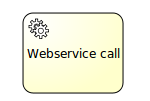
XML representation
To use a Web service we need to import its operations and complex types. This can be done automatically by using the import tag pointing to the WSDL of the Web service:
<import importType="http://schemas.xmlsoap.org/wsdl/"
location="http://localhost:63081/counter?wsdl"
namespace="http://webservice.flowable.org/" />
The previous declaration tells Flowable to import the definitions, but it doesn’t create the item definitions and messages for you. Let’s suppose we want to invoke a specific method called 'prettyPrint', therefore we will need to create the corresponding message and item definitions for the request and response messages:
<message id="prettyPrintCountRequestMessage" itemRef="tns:prettyPrintCountRequestItem" />
<message id="prettyPrintCountResponseMessage" itemRef="tns:prettyPrintCountResponseItem" />
<itemDefinition id="prettyPrintCountRequestItem" structureRef="counter:prettyPrintCount" />
<itemDefinition id="prettyPrintCountResponseItem" structureRef="counter:prettyPrintCountResponse" />
Before declaring the service task, we have to define the BPMN interfaces and operations that actually reference the Web service ones. Basically, we define and 'interface' and the required 'operations'. For each operation we reuse the previous defined message for 'in' and 'out'. For example, the following declaration defines the 'counter' interface and the 'prettyPrintCountOperation' operation:
<interface name="Counter Interface" implementationRef="counter:Counter">
<operation id="prettyPrintCountOperation" name="prettyPrintCount Operation"
implementationRef="counter:prettyPrintCount">
<inMessageRef>tns:prettyPrintCountRequestMessage</inMessageRef>
<outMessageRef>tns:prettyPrintCountResponseMessage</outMessageRef>
</operation>
</interface>
Then we can declare a Web Service Task by using the ##WebService implementation and a reference to the Web service operation.
<serviceTask id="webService"
name="Web service invocation"
implementation="##WebService"
operationRef="tns:prettyPrintCountOperation">
Web Service Task IO Specification
Unless we are using the simplistic approach for data input and output associations (see below), each Web Service Task needs to declare an IO Specification that specifies the inputs and outputs of the task. The approach is pretty straightforward and BPMN 2.0 complaint, for our prettyPrint example we define the input and output sets according to the previously declared item definitions:
<ioSpecification>
<dataInput itemSubjectRef="tns:prettyPrintCountRequestItem" id="dataInputOfServiceTask" />
<dataOutput itemSubjectRef="tns:prettyPrintCountResponseItem" id="dataOutputOfServiceTask" />
<inputSet>
<dataInputRefs>dataInputOfServiceTask</dataInputRefs>
</inputSet>
<outputSet>
<dataOutputRefs>dataOutputOfServiceTask</dataOutputRefs>
</outputSet>
</ioSpecification>
Web Service Task data input associations
There are 2 ways of specifying data input associations:
Using expressions
Using the simplistic approach
To specify the data input association using expressions, we need to define the source and target items and specify the corresponding assignments between the fields of each item. In the following example we assign prefix and suffix fields for the items:
<dataInputAssociation>
<sourceRef>dataInputOfProcess</sourceRef>
<targetRef>dataInputOfServiceTask</targetRef>
<assignment>
<from>${dataInputOfProcess.prefix}</from>
<to>${dataInputOfServiceTask.prefix}</to>
</assignment>
<assignment>
<from>${dataInputOfProcess.suffix}</from>
<to>${dataInputOfServiceTask.suffix}</to>
</assignment>
</dataInputAssociation>
On the other hand, we can use the simplistic approach, which is much more straightforward. The 'sourceRef' element is a Flowable variable name and the 'targetRef' element is a property of the item definition. In the following example, we assign the 'prefix' field the value of the variable 'PrefixVariable', and the 'suffix' field the value of the variable 'SuffixVariable'.
<dataInputAssociation>
<sourceRef>PrefixVariable</sourceRef>
<targetRef>prefix</targetRef>
</dataInputAssociation>
<dataInputAssociation>
<sourceRef>SuffixVariable</sourceRef>
<targetRef>suffix</targetRef>
</dataInputAssociation>
Web Service Task data output associations
There are 2 ways of specifying data out associations:
Using expressions
Using the simplistic approach
To specify the data out association using expressions we need to define the target variable and the source expression. The approach is pretty straightforward and similar to data input associations:
<dataOutputAssociation>
<targetRef>dataOutputOfProcess</targetRef>
<transformation>${dataOutputOfServiceTask.prettyPrint}</transformation>
</dataOutputAssociation>
Alternatively, we can use the simplistic approach that is much more straightforward. The 'sourceRef' element is a property of the item definition and the 'targetRef' element is a Flowable variable name. The approach is pretty simple and similar to data input associations:
<dataOutputAssociation>
<sourceRef>prettyPrint</sourceRef>
<targetRef>OutputVariable</targetRef>
</dataOutputAssociation>
Business Rule Task
Description
A Business Rule task is used to synchronously execute one or more rules. Flowable uses Drools Expert, the Drools rule engine to execute business rules. Currently, the .drl files containing the business rules have to be deployed together with the process definition that defines a business rule task to execute those rules. This means that all .drl files that are used in a process have to be packaged in the process BAR file, as for task forms and so on. For more information about creating business rules for Drools Expert, please refer to the Drools documentation at JBoss Drools
If you want to plug in your own implementation of the rule task, for example, because you want to use Drools differently or you want to use a completely different rule engine, then you can use the class or expression attribute on the BusinessRuleTask and it will behave exactly like a ServiceTask
Graphical Notation
A Business Rule task is visualized the with a table icon.

XML representation
To execute one or more business rules that are deployed in the same BAR file as the process definition, we need to define the input and result variables. For the input variable definition, a list of process variables can be defined separated by a comma. The output variable definition can only contain one variable name that will be used to store the output objects of the executed business rules in a process variable. Note that the result variable will contain a List of objects. If no result variable name is specified by default, org.flowable.engine.rules.OUTPUT is used.
The following business rule task executes all business rules deployed with the process definition:
<process id="simpleBusinessRuleProcess">
<startEvent id="theStart" />
<sequenceFlow sourceRef="theStart" targetRef="businessRuleTask" />
<businessRuleTask id="businessRuleTask" flowable:ruleVariablesInput="${order}"
flowable:resultVariable="rulesOutput" />
<sequenceFlow sourceRef="businessRuleTask" targetRef="theEnd" />
<endEvent id="theEnd" />
</process>
The business rule task can also be configured to execute only a defined set of rules from the deployed .drl files. A list of rule names separated by a comma must be specified for this.
<businessRuleTask id="businessRuleTask" flowable:ruleVariablesInput="${order}"
flowable:rules="rule1, rule2" />
In this case only rule1 and rule2 are executed.
You can also define a list of rules that should be excluded from execution.
<businessRuleTask id="businessRuleTask" flowable:ruleVariablesInput="${order}"
flowable:rules="rule1, rule2" exclude="true" />
In this case all rules deployed in the same BAR file as the process definition will be executed, except for rule1 and rule2.
As mentioned earlier another option is to hook in the implementation of the BusinessRuleTask yourself:
<businessRuleTask id="businessRuleTask" flowable:class="${MyRuleServiceDelegate}" />
Now the BusinessRuleTask behaves exactly like a ServiceTask, but still keeps the BusinessRuleTask icon to visualize that we are doing business rule processing here.
Email Task
Flowable allows you to enhance business processes with automatic mail service tasks that send e-mails to one or more recipients, including support for cc, bcc, HTML content, and so on. Note that the mail task is not an 'official' task of the BPMN 2.0 spec (and doesn’t have a dedicated icon as a consequence). Hence, in Flowable the mail task is implemented as a dedicated service task.
Mail server configuration
The Flowable engine sends e-mails trough an external mail server with SMTP capabilities. To actually send e-mails, the engine needs to know how to reach the mail server. The following properties can be set in the flowable.cfg.xml configuration file:
| Property | Required? | Description |
|---|---|---|
mailServerHost |
no |
The hostname of your mail server (for example, mail.mycorp.com). Default is localhost |
mailServerPort |
yes, if not on the default port |
The port for SMTP traffic on the mail server. The default is 25 |
mailServerForceTo |
no |
If set it will be used as a replacement of the configured to, cc and / or bcc in the Mail Task when sending out emails. |
mailServerDefaultFrom |
no |
The default e-mail address of the sender of e-mails, when none is provided by the user. By default this is flowable@localhost |
mailServerUsername |
if applicable for your server |
Some mail servers require credentials for sending e-mail. By default not set. |
mailServerPassword |
if applicable for your server |
Some mail servers require credentials for sending e-mail. By default not set. |
mailServerUseSSL |
if applicable for your server |
Some mail servers require ssl communication. By default set to false. |
mailServerUseTLS |
if applicable for your server |
Some mail servers (for instance gmail) require TLS communication. By default set to false. |
Defining an Email Task
The Email task is implemented as a dedicated Service Task and is defined by setting 'mail' for the type of the service task.
<serviceTask id="sendMail" flowable:type="mail">
The Email task is configured by field injection. All the values for these properties can contain EL expression, which are resolved at runtime during process execution. The following properties can be set:
| Property | Required? | Description |
|---|---|---|
to |
yes |
The recipients of the e-mail. Multiple recipients are defined in a comma-separated list |
from |
no |
The sender e-mail address. If not provided, the default configured from address is used. |
subject |
no |
The subject of the e-mail. |
cc |
no |
The cc’s of the e-mail. Multiple recipients are defined in a comma-separated list |
bcc |
no |
The bcc’s of the e-mail. Multiple recipients are defined in a comma-separated list |
charset |
no |
Allows specification of the charset of the email, which is necessary for many non-English languages. |
html |
no |
A piece of HTML that is the content of the e-mail. |
text |
no |
The content of the e-mail, in case one needs to send plain, non-rich e-mails. Can be used in combination with html, for e-mail clients that don’t support rich content. The email client can then fall back to this text-only alternative. |
htmlVar |
no |
The name of a process variable that holds the HTML that is the content of the e-mail. The key difference between this and html is that this content will have expressions replaced before being sent by the mail task. |
textVar |
no |
The name of a process variable that holds the plain text content of the e-mail. The key difference between this and text is that this content will have expressions replaced before being sent by the mail task. |
ignoreException |
no |
Whether a failure when handling the e-mail is ignored rather than throw a FlowableException. By default this is set to false. |
exceptionVariableName |
no |
When email handling does not throw an exception because ignoreException = true, a variable with the given name is used to hold a failure message |
Example usage
The following XML snippet shows an example of using the Email Task.
<serviceTask id="sendMail" flowable:type="mail">
<extensionElements>
<flowable:field name="from" stringValue="order-shipping@thecompany.com" />
<flowable:field name="to" expression="${recipient}" />
<flowable:field name="subject" expression="Your order ${orderId} has been shipped" />
<flowable:field name="html">
<flowable:expression>
<![CDATA[
<html>
<body>
Hello ${male ? 'Mr.' : 'Mrs.' } ${recipientName},<br/><br/>
As of ${now}, your order has been <b>processed and shipped</b>.<br/><br/>
Kind regards,<br/>
TheCompany.
</body>
</html>
]]>
</flowable:expression>
</flowable:field>
</extensionElements>
</serviceTask>
Http Task
The Http task allows to make HTTP requests, enhancing the integration features of Flowable. Note that Http task is not an 'official' task of the BPMN 2.0 spec (and doesn’t have a dedicated icon as a consequence). Hence, in Flowable, Http task is implemented as a dedicated service task.
Http Client configuration
The Flowable engine makes Http requests through a configurable Http Client. If none is set, default settings are used.
Example configuration:
<bean id="processEngineConfiguration"
class="org.flowable.engine.impl.cfg.StandaloneProcessEngineConfiguration">
<!-- http client configurations -->
<property name="httpClientConfig" ref="httpClientConfig"/>
</bean>
<bean id="httpClientConfig" class="org.flowable.engine.cfg.HttpClientConfig">
<property name="connectTimeout" value="5000"/>
<property name="socketTimeout" value="5000"/>
<property name="connectionRequestTimeout" value="5000"/>
<property name="requestRetryLimit" value="5"/>
</bean>
| Property | Required? | Description |
|---|---|---|
connectTimeout |
no |
Connection timeout in milliseconds. |
socketTimeout |
no |
Socket timeout in milliseconds. |
connectionRequestTimeout |
no |
Connection request timeout in milliseconds. |
requestRetryLimit |
no |
Request retry limit ('0' means do not retry). |
disableCertVerify |
no |
Flag to disable SSL certificate verification. |
Defining Http Task
The Http task is implemented as a dedicated Service Task and is defined by setting 'http' for the type of the service task.
<serviceTask id="httpGet" flowable:type="http">
It is possible to override the default Http Task behavior by providing a custom implementation. Custom implementations should extend org.flowable.engine.impl.bpmn.http.DefaultBpmnHttpActivityDelegate and override the methods you need.
The field 'httpActivityBehaviorClass' should be set in the task definition (Default value for this field is 'org.flowable.engine.impl.bpmn.http.DefaultBpmnHttpActivityDelegate').
The http client is abstracted through FlowableHttpClient. The default implementation when using the flowable-http dependency is based on the Apache Http Client.
As Apache Http Client can be customized in many ways, all possible options are not used in the Http Client config.
There is also an implementation based on the Spring WebClient, which will be used when the Apache Http Client is not on the classpath.
To create a custom client refer to Http Client builder
<serviceTask id="httpGet" flowable:type="http">
<extensionElements>
<flowable:field name="httpActivityBehaviorClass">
<flowable:string>
<![CDATA[org.example.flowable.HttpActivityBehaviorCustomImpl]]>
</flowable:string>
</flowable:field>
</extensionElements>
</serviceTask>
Http Task configuration
The Http task is configured by field injection. All the values for these properties can contain EL expression, which are resolved at runtime during execution. The following properties can be set:
| Property | Required? | Description |
|---|---|---|
requestMethod |
yes |
Request method |
requestUrl |
yes |
Request URL |
requestHeaders |
no |
Line separated Http request headers. |
requestBody |
no |
Request body |
requestTimeout |
no |
Timeout in milliseconds for the request |
disallowRedirects |
no |
Flag to disallow Http redirects. |
failStatusCodes |
no |
Comma separated list of Http response status codes to fail the request and throw a FlowableException. |
handleStatusCodes |
no |
Comma separated list of status codes for which the task will throw BpmnError which can be caught by a boundary error event. |
ignoreException |
no |
Flag for ignoring the exceptions. The exception is caught and stored as a variable with the name '<taskId>ErrorMessage'. |
saveRequestVariables |
no |
Flag to save request variables. |
saveResponseParameters |
no |
Flag to save all response variables including HTTP status, headers etc. |
resultVariablePrefix |
no |
Prefix for the execution variable names. |
saveResponseParametersTransient |
no |
If resolves to true, the response body variable (and response header, status, etc. if set to be stored) will be stored as a transient variable. |
saveResponseVariableAsJson |
no |
If resolves to true, the response body value will be stored as a JSON variable instead of a String. This is useful if the HTTP service returns JSON and you want to reference the fields using the dot notation (e.g. myResponse.user.name) later on. |
parallelInSameTransaction |
- |
If resolves to true, the HTTP call will be done on a different thread and thus making it possible to execute more HTTP tasks in parallel. This is useful when parallel gateways are used and there are multiple HTTP tasks in the parallel flows. |
httpActivityBehaviorClass |
no |
Full class name of custom extension of org.flowable.engine.impl.bpmn.http.DefaultBpmnHttpActivityDelegate. |
In addition to the provided fields, following will be set as variables on successful execution, based on 'saveResponseParameters' flag.
| Variable | Optional? | Description |
|---|---|---|
responseProtocol |
Yes |
Http version |
responseReason |
Yes |
Http response reason phrase. |
responseStatusCode |
Yes |
Http response status code (Example - 200). |
responseHeaders |
Yes |
Line separated Http response headers. |
responseBody |
Yes |
Response body as string, if any. |
errorMessage |
Yes |
Ignored error message, if any. |
Result variables
Remember all the above execution variable names are prefixed by evaluated value of 'resultVariablePrefix'. For example the response status code can be accessed in another activity as 'task7ResponseStatusCode'. Here 'task7' is the 'id' of the service task. To override this behavior, set 'resultVariablePrefix' as required.
Example usage
The following XML snippet shows an example of using the Http Task.
<serviceTask id="httpGet" flowable:type="http">
<extensionElements>
<flowable:field name="requestMethod" stringValue="GET" />
<flowable:field name="requestUrl" stringValue="http://flowable.org" />
<flowable:field name="requestHeaders">
<flowable:expression>
<![CDATA[
Accept: text/html
Cache-Control: no-cache
]]>
</flowable:expression>
</flowable:field>
<flowable:field name="requestTimeout">
<flowable:expression>
<![CDATA[
${requestTimeout}
]]>
</flowable:expression>
</flowable:field>
<flowable:field name="resultVariablePrefix">
<flowable:string>task7</flowable:string>
</flowable:field>
</extensionElements>
</serviceTask>
Error handling
By default Http Task throws a FlowableException when Connection, IO or any unhandled exceptions occur. By default any redirect/client/server error http status codes are not handled.
The Http task can be configured to handle the exceptions and http status by setting 'failStatusCodes' and/or 'handleStatusCodes' fields. Refer Http Task configuration.
The BpmnError thrown by 'handleStatusCodes' should be handled exactly like a normal BPMN exception, by having a corresponding boundary error event. Below are few examples for exception handling and retry for http task.
Fail on '400' and 5XX, async http task and retry with failedJobRetryTimeCycle
<serviceTask id="failGet" name="Fail test" flowable:async="true" flowable:type="http">
<extensionElements>
<flowable:field name="requestMethod">
<flowable:string><![CDATA[GET]]></flowable:string>
</flowable:field>
<flowable:field name="requestUrl">
<flowable:string><![CDATA[http://localhost:9798/api/fail]]></flowable:string>
</flowable:field>
<flowable:field name="failStatusCodes">
<flowable:string><![CDATA[400, 5XX]]></flowable:string>
</flowable:field>
<flowable:failedJobRetryTimeCycle>R3/PT5S</flowable:failedJobRetryTimeCycle>
</extensionElements>
</serviceTask>
Handle '400' as BmpnError
<serviceTask id="handleGet" name="HTTP Task" flowable:type="http">
<extensionElements>
<flowable:field name="requestMethod">
<flowable:string><![CDATA[GET]]></flowable:string>
</flowable:field>
<flowable:field name="requestUrl">
<flowable:string><![CDATA[http://localhost:9798/api/fail]]></flowable:string>
</flowable:field>
<flowable:field name="handleStatusCodes">
<flowable:string><![CDATA[4XX]]></flowable:string>
</flowable:field>
</extensionElements>
</serviceTask>
<boundaryEvent id="catch400" attachedToRef="handleGet">
<errorEventDefinition errorRef="HTTP400"></errorEventDefinition>
</boundaryEvent>
Ignore exceptions.
<serviceTask id="ignoreTask" name="Fail test" flowable:type="http">
<extensionElements>
<flowable:field name="requestMethod">
<flowable:string><![CDATA[GET]]></flowable:string>
</flowable:field>
<flowable:field name="requestUrl">
<flowable:string><![CDATA[http://nohost:9798/api]]></flowable:string>
</flowable:field>
<flowable:field name="ignoreException">
<flowable:string><![CDATA[true]]></flowable:string>
</flowable:field>
</extensionElements>
</serviceTask>
Exception mapping
Refer Exception mapping
Camel Task
The Camel task allows you to send messages to and receive messages from Camel, and thereby enhances the integration features of Flowable. Note that the Camel task is not an 'official' task of the BPMN 2.0 spec (and doesn’t have a dedicated icon as a consequence). Hence, in Flowable the Camel task is implemented as a dedicated service task. Also note that you must include the Flowable Camel module in your project to use the Camel task functionality.
Defining a Camel Task
The Camel task is implemented as a dedicated Service Task and is defined by setting 'camel' for the type of the service task.
<serviceTask id="sendCamel" flowable:type="camel">
The process definition itself needs nothing other than the camel type definition on a service task. The integration logic is all delegated to the Camel container. By default, the Flowable engine looks for a camelContext bean in the Spring container. The camelContext bean defines the Camel routes that will be loaded by the Camel container. In the following example, the routes are loaded from a specific Java package, but you can also define routes directly in the Spring configuration itself.
<camelContext id="camelContext" xmlns="http://camel.apache.org/schema/spring">
<packageScan>
<package>org.flowable.camel.route</package>
</packageScan>
</camelContext>
For more documentation about Camel routes you can look on the Camel website. The basic concepts are demonstrated through a few small samples below. In the first sample, we will do the simplest form of Camel call from a Flowable workflow. Let’s call it SimpleCamelCall.
If you want to define multiple Camel context beans or want to use a different bean name, this can be overridden in the Camel task definition like this:
<serviceTask id="serviceTask1" flowable:type="camel">
<extensionElements>
<flowable:field name="camelContext" stringValue="customCamelContext" />
</extensionElements>
</serviceTask>
Simple Camel Call example
All the files related to this example can be found in the org.flowable.camel.examples.simpleCamelCall package of flowable-camel module. The target simply activates a specific Camel route. First of all, we need a Spring context that contains the introduction to the routes as mentioned previously. The following serves this purpose:
<camelContext id="camelContext" xmlns="http://camel.apache.org/schema/spring">
<packageScan>
<package>org.flowable.camel.examples.simpleCamelCall</package>
</packageScan>
</camelContext>
public class SimpleCamelCallRoute extends RouteBuilder {
@Override
public void configure() throws Exception {
from("flowable:SimpleCamelCallProcess:simpleCall").to("log:org.flowable.camel.examples.SimpleCamelCall");
}
}
The route just logs the message body and nothing more. Notice the format of the from endpoint. It consists of three parts:
| Endpoint URL Part | Description |
|---|---|
flowable |
refers to the engine endpoint |
SimpleCamelCallProcess |
name of the process |
simpleCall |
name of the Camel service in the process |
OK, our route is now properly configured and accessible to Camel. Now comes the workflow part. The workflow looks like:
<process id="SimpleCamelCallProcess">
<startEvent id="start"/>
<sequenceFlow id="flow1" sourceRef="start" targetRef="simpleCall"/>
<serviceTask id="simpleCall" flowable:type="camel"/>
<sequenceFlow id="flow2" sourceRef="simpleCall" targetRef="end"/>
<endEvent id="end"/>
</process>
Ping Pong example
Our example worked, but nothing is really transferred between Camel and Flowable so there is not much merit in it. In this example, we try to send and receive data to and from Camel. We send a string, Camel concatenates something to it and returns back the result. The sender part is trivial, we send our message in the form of a variable to Camel Task. Here is our caller code:
@Deployment
public void testPingPong() {
Map<String, Object> variables = new HashMap<String, Object>();
variables.put("input", "Hello");
Map<String, String> outputMap = new HashMap<String, String>();
variables.put("outputMap", outputMap);
runtimeService.startProcessInstanceByKey("PingPongProcess", variables);
assertEquals(1, outputMap.size());
assertNotNull(outputMap.get("outputValue"));
assertEquals("Hello World", outputMap.get("outputValue"));
}
The variable "input" is actually the input for the Camel route, and outputMap is there to capture the result back from Camel. The process could be something like this:
<process id="PingPongProcess">
<startEvent id="start"/>
<sequenceFlow id="flow1" sourceRef="start" targetRef="ping"/>
<serviceTask id="ping" flowable:type="camel"/>
<sequenceFlow id="flow2" sourceRef="ping" targetRef="saveOutput"/>
<serviceTask id="saveOutput" flowable:class="org.flowable.camel.examples.pingPong.SaveOutput" />
<sequenceFlow id="flow3" sourceRef="saveOutput" targetRef="end"/>
<endEvent id="end"/>
</process>
Note that SaveOutput Service task stores the value of "Output" variable from the context to the previously mentioned OutputMap. Now we have to know how the variables are sent to Camel and returned back. Here comes the notion of Camel behavior into play. The way variables are communicated to Camel is configurable via CamelBehavior. Here we use the default one in our sample, a short description of the other ones comes afterwards. With similar code you can configure the desired Camel behavior:
<serviceTask id="serviceTask1" flowable:type="camel">
<extensionElements>
<flowable:field name="camelBehaviorClass" stringValue="org.flowable.camel.impl.CamelBehaviorCamelBodyImpl" />
</extensionElements>
</serviceTask>
If you do not give a specific behavior, then org.flowable.camel.impl.CamelBehaviorDefaultImpl will be set. This behavior copies the variables to Camel properties of the same name. In return, regardless of selected behavior, if the Camel message body is a map, then each of its elements is copied as a variable, else the whole object is copied into a specific variable with the name of "camelBody". Knowing this, this Camel route concludes our second example:
@Override
public void configure() throws Exception {
from("flowable:PingPongProcess:ping").transform().simple("${exchangeProperty.input} World");
}
In this route, the string "world" is concatenated to the end of the property named "input" and the result will be set in the message body. It’s accessible by checking the "camelBody" variable in the Java service task and copied to "outputMap". Now that the example with its default behavior works, let’s see what the other possibilities are. In starting every Camel route, the Process Instance ID will be copied into a Camel property with the specific name of "PROCESS_ID_PROPERTY". It’s later used for correlating the process instance and Camel route. Also, it can be exploited in the Camel route.
There are three different behaviors already available out of the box in Flowable. The behavior can be overwritten by a specific phrase in the route URL. Here’s an example of overriding the already defined behavior in the URL:
from("flowable:asyncCamelProcess:serviceTaskAsync2?copyVariablesToProperties=true").
The following table provides an overview of three available Camel behaviors:
| Behavior | In URL | Description |
|---|---|---|
CamelBehaviorDefaultImpl |
copyVariablesToProperties |
Copy Flowable variables as Camel properties |
CamelBehaviorCamelBodyImpl |
copyCamelBodyToBody |
Copy only the Flowable variable named "camelBody" as the Camel message body |
CamelBehaviorBodyAsMapImpl |
copyVariablesToBodyAsMap |
Copy all the Flowable variables in a map as the Camel message body |
The above table describes how Flowable variables are going to be transferred to Camel. The following table describes how the Camel variables are returned back to Flowable. This can only be configured in route URLs.
| URL | Description |
|---|---|
Default |
If Camel body is a map, copy each element as a Flowable variable, otherwise copy the whole Camel body as a "camelBody" Flowable variable |
copyVariablesFromProperties |
Copy Camel properties as Flowable variables of the same name |
copyCamelBodyToBodyAsString |
As for default, but if camelBody is not a map, first convert it to String and then copy it into "camelBody" |
copyVariablesFromHeader |
Additionally copy Camel headers to Flowable variables of the same names |
Returning back the variables
What is mentioned above about passing variables only holds for the initiating side of the variable transfer, whether you’re coming from from Camel to Flowable or from Flowable to Camel.
It is important to note that because of the special non-blocking behavior of Flowable, variables are not automatically returned back from Flowable to Camel.
For that to happen, a special syntax is available. There can be one or more parameters in a Camel route URL with the format of var.return.someVariableName.
All variables having a name equal to one of these parameters (without var.return part) will be considered as output variables and will be copied back as Camel properties with the same names.
For example in a route like:
from("direct:start").to("flowable:process?var.return.exampleVar").to("mock:result");
A Flowable variable with the name of exampleVar will be considered as an output variable and will be copied back as a property in Camel with the same name.
Asynchronous Ping Pong example
All the previous examples were synchronous. The process instance waits until the Camel route is concluded and returned. In some cases, we might need the Flowable process instance to continue. For such purposes, the asynchronous capability of the Camel service task is useful. You can make use of this feature by setting the async property of the Camel service task to true.
<serviceTask id="serviceAsyncPing" flowable:type="camel" flowable:async="true"/>
By setting this feature, the specified Camel route is activated asynchronously by the Flowable job executor. When you define a queue in the Camel route, the Flowable process instance will continue with the activities defined after the Camel service task in the process definition. The Camel route will be executed fully asynchronously from the process execution. If you want to wait for a response of the Camel service task somewhere in your process definition, you can use a receive task.
<receiveTask id="receiveAsyncPing" name="Wait State" />
The process instance will wait until a signal is received, for example from Camel. In Camel you can send a signal to the process instance by sending a message to the proper Flowable endpoint.
from("flowable:asyncPingProcess:serviceAsyncPing").to("flowable:asyncPingProcess:receiveAsyncPing");
constant string "flowable"
process name
receive task name
Instantiate workflow from Camel route
In all the previous examples, the Flowable process instance is started first and the Camel route was started from the process instance. It is also possible to do things the other way around, with a process instance being started or invoked from an already started Camel route. It’s very similar to signalling a receive task. Here’s a sample route:
from("direct:start").to("flowable:camelProcess");
As you can see, the URL has two parts: the first is the constant string "flowable" and the second is the name of the process definition. Obviously, the process definition should already be deployed to the Flowable engine.
It is also possible to set the initiator of the process instance to some authenticated user ID that is provided in a Camel header. To achieve this, first of all, an initiator variable must be specified in the process definition:
<startEvent id="start" flowable:initiator="initiator" />
Then given that the user ID is contained in a Camel header named CamelProcessInitiatorHeader, the Camel route could be defined as follows:
from("direct:startWithInitiatorHeader")
.setHeader("CamelProcessInitiatorHeader", constant("kermit"))
.to("flowable:InitiatorCamelCallProcess?processInitiatorHeaderName=CamelProcessInitiatorHeader");
Manual Task
Description
A Manual Task defines a task that is external to the BPM engine. It’s used to model work that is done by somebody, which the engine does not need to know of, nor is there a system or user interface. For the engine, a manual task is handled as a pass-through activity, automatically continuing the process from the moment process execution arrives into it.
Graphical Notation
A manual task is visualized as a rounded rectangle, with a little 'hand' icon in the upper left corner
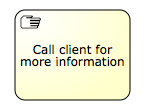
XML representation
<manualTask id="myManualTask" name="Call client for more information" />
Java Receive Task
Description
A Receive Task is a simple task that waits for the arrival of a certain message. Currently, we have only implemented Java semantics for this task. When process execution arrives at a Receive Task, the process state is committed to the persistence store. This means that the process will stay in this wait state until a specific message is received by the engine, which triggers the continuation of the process past the Receive Task.
Graphical notation
A Receive Task is visualized as a task (rounded rectangle) with a message icon in the top left corner. The message is white (a black message icon would have send semantics)
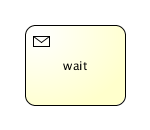
XML representation
<receiveTask id="waitState" name="wait" />
To continue a process instance that is currently waiting at such a Receive Task, the runtimeService.trigger(executionId) must be called using the ID of the execution that arrived in the Receive Task. The following code snippet shows how this works in practice:
ProcessInstance pi = runtimeService.startProcessInstanceByKey("receiveTask");
Execution execution = runtimeService.createExecutionQuery()
.processInstanceId(pi.getId())
.activityId("waitState")
.singleResult();
assertNotNull(execution);
runtimeService.trigger(execution.getId());
Shell Task
Description
The Shell task allows you to run shell scripts and commands. Note that the Shell task is not an 'official' task of BPMN 2.0 spec (and doesn’t have a dedicated icon as a consequence).
Defining a Shell task
The Shell task is implemented as a dedicated Service Task and is defined by setting 'shell' for the type of the service task.
<serviceTask id="shellEcho" flowable:type="shell">
The Shell task is configured by field injection. All the values for these properties can contain EL expression, which are resolved at runtime during process execution. The following properties can be set:
| Property | Required? | Type | Description | Default |
|---|---|---|---|---|
command |
yes |
String |
Shell command to execute. |
|
arg1-5 |
no |
String |
Parameter 1 to Parameter 5 |
|
wait |
no |
true/false |
Wait if necessary, until the shell process has terminated. |
true |
redirectError |
no |
true/false |
Merge standard error with the standard output. |
false |
cleanEnv |
no |
true/false |
Shell process does not inherit current environment. |
false |
outputVariable |
no |
String |
Name of variable to hold the output |
Output is not recorded. |
errorCodeVariable |
no |
String |
Name of variable to hold any result error code |
Error level is not registered. |
directory |
no |
String |
Default directory of the shell process |
Current directory |
Example usage
The following XML snippet shows an example of using the Shell Task. It runs the shell script "cmd /c echo EchoTest", waits for it to be terminated and puts the result in resultVar:
<serviceTask id="shellEcho" flowable:type="shell" >
<extensionElements>
<flowable:field name="command" stringValue="cmd" />
<flowable:field name="arg1" stringValue="/c" />
<flowable:field name="arg2" stringValue="echo" />
<flowable:field name="arg3" stringValue="EchoTest" />
<flowable:field name="wait" stringValue="true" />
<flowable:field name="outputVariable" stringValue="resultVar" />
</extensionElements>
</serviceTask>
External Worker Task
Description
The External Worker Task allows you to create jobs that should be acquired and executed by External Workers. An External Worker can acquire jobs over the Java API or REST API. This is similar to an async Service Task. The difference is that instead of Flowable executing the logic, an External Worker, which can be implemented in any language, queries Flowable for jobs, executes them and sends the result to Flowable. Note that the External Worker task is not an 'official' task of BPMN 2.0 spec (and doesn’t have a dedicated icon as a consequence).
Defining an External Worker Task
The External Worker task is implemented as a dedicated Service Task and is defined by setting 'external-worker' for the type of the service task.
<serviceTask id="externalWorkerOrder" flowable:type="external-worker">
The External Worker task is configured by setting the topic (can be an EL expression) which the External Worker uses to query for jobs to execute.
Example usage
The following XML snippet shows an example of using the External Worker Task. The External Worker is a wait state. When the execution reaches the task it will create an External Worker Job, which can be acquired by an External Worker. Once the External Worker is done with the job and notifies Flowable of the completion the execution of the process will continue.
<serviceTask id="externalWorkerOrder" flowable:type="external-worker" flowable:topic="orderService" />
Acquiring External Worker Job
External Worker Jobs are acquired via the ManagementService#createExternalWorkerJobAcquireBuilder by using a ExternalWorkerJobAcquireBuilder
List<AcquiredExternalWorkerJob> acquiredJobs = managementService.createExternalWorkerJobAcquireBuilder()
.topic("orderService", Duration.ofMinutes(30))
.acquireAndLock(5, "orderWorker-1");
By using the above Java snippet External Worker jobs can be acquired. With the snippet we did the following:
- Query for External Worker Jobs with the topic orderService.
- Acquire and lock the jobs for 30 minutes waiting for the completion signal from the External Worker.
- Acquire maximum of 5 jobs
- The owner of the jobs is the worker with id orderWorker-1
An AcquiredExternalWorkerJob also has access to the Process variables.
When the External Worker Task is exclusive, acquiring the job will lock the Process Instance.
Completing an External Worker Job
External Worker Jobs are completed via the ManagementService#createExternalWorkerCompletionBuilder(String, String) by using an ExternalWorkerCompletionBuilder
managementService.createExternalWorkerCompletionBuilder(acquiredJob.getId(), "orderWorker-1")
.variable("orderStatus", "COMPLETED")
.complete();
A Job can be completed only by the worker that acquired it. Otherwise a FlowableIllegalArgumentException will be thrown.
Using the snippet above the task is completed and the process execution will continue. The continuation of the execution is done asynchronously in a new transaction. This means that completing an external worker task will only create an asynchronous (new) job to execute the completion (and the current thread returns after doing that). Any steps in the model that follow after the external worker task will be executed in that transaction, similar to a regular async service task.
Error handling for an External Worker Job
There are 2 ways of handling errors for an external worker job:
- Business error via
ManagementService#createExternalWorkerCompletionBuilder(String, String)by using anExternalWorkerCompletionBuilder
managementService.createExternalWorkerCompletionBuilder(acquiredJob.getId(), "orderWorker-1")
.variable("orderStatus", "FAILED")
.bpmnError("orderFailed");
With this snippet the orderStatus variable will be set on the process and a BPMN Error with the code orderFailed will be thrown. A BPMN Error can only be thrown by the worker that acquired the job.
- Technical error via
ManagementService#createExternalWorkerJobFailureBuilder(String, String)by using anExternalWorkerJobFailureBuilder
managementService.createExternalWorkerJobFailureBuilder(acquiredJob.getId(), "orderWorker-1")
.errorMessage("Failed to run job. Database not accessible")
.errorDetails("Some complex and long error details")
.retries(4)
.retryTimeout(Duration.ofHours(1))
.fail();
With this snippet the following will be done:
- The error message and error details will be set on the job
- The retry count for the job will be set to 4
- The job will be available for acquiring after 1 hour
The Job can only be failed by the worker that acquired it. If no retries have been set, flowable will automatically decrease the number of retries for a job by 1. When the number of retries is 0 the job will be moved to the DeadLetter table job and will no longer be available for acquiring.
Querying External Worker Jobs
External Worker Jobs are queried by using the ExternalWorkerJobQuery by creating it via ManagementService#createExternalWorkerJobQuery.
Execution listener
Execution listeners allow you to execute external Java code or evaluate an expression when certain events occur during process execution. The events that can be captured are:
Starting and ending a process instance.
Taking a transition.
Starting and ending an activity.
Starting and ending a gateway.
Starting and ending an intermediate event.
Ending a start event and starting an end event.
The following process definition contains 3 execution listeners:
<process id="executionListenersProcess">
<extensionElements>
<flowable:executionListener
class="org.flowable.examples.bpmn.executionlistener.ExampleExecutionListenerOne"
event="start" />
</extensionElements>
<startEvent id="theStart" />
<sequenceFlow sourceRef="theStart" targetRef="firstTask" />
<userTask id="firstTask" />
<sequenceFlow sourceRef="firstTask" targetRef="secondTask">
<extensionElements>
<flowable:executionListener
class="org.flowable.examples.bpmn.executionListener.ExampleExecutionListenerTwo" />
</extensionElements>
</sequenceFlow>
<userTask id="secondTask" >
<extensionElements>
<flowable:executionListener
expression="${myPojo.myMethod(execution.event)}"
event="end" />
</extensionElements>
</userTask>
<sequenceFlow sourceRef="secondTask" targetRef="thirdTask" />
<userTask id="thirdTask" />
<sequenceFlow sourceRef="thirdTask" targetRef="theEnd" />
<endEvent id="theEnd" />
</process>
The first execution listener is notified when the process starts. The listener is an external Java-class (ExampleExecutionListenerOne) and should implement an org.flowable.engine.delegate.ExecutionListener interface. When the event occurs (in this case end event), the method notify(ExecutionListenerExecution execution) is called.
public class ExampleExecutionListenerOne implements ExecutionListener {
public void notify(ExecutionListenerExecution execution) throws Exception {
execution.setVariable("variableSetInExecutionListener", "firstValue");
execution.setVariable("eventReceived", execution.getEventName());
}
}
It is also possible to use a delegation class that implements the org.flowable.engine.delegate.JavaDelegate interface. These delegation classes can then be reused in other constructs, such as a delegation for a serviceTask.
The second execution listener is called when the transition is taken. Note that the listener element doesn’t define an event, since only take events are fired on transitions. Values in the event attribute are ignored when a listener is defined on a transition.
The last execution listener is called when the activity secondTask ends. Instead of using the class on the listener declaration, a expression is defined instead, which is evaluated/invoked when the event is fired.
<flowable:executionListener expression="${myPojo.myMethod(execution.eventName)}" event="end" />
As with other expressions, execution variables are resolved and can be used. Because the execution implementation object has a property that exposes the event name, it’s possible to pass the event-name to your methods using execution.eventName.
Execution listeners also support using a delegateExpression, similar to a service task.
<flowable:executionListener event="start" delegateExpression="${myExecutionListenerBean}" />
A while back, we also introduced a new type of execution listener, the org.flowable.engine.impl.bpmn.listener.ScriptExecutionListener. This script execution listener allows you to execute a piece of script logic for an execution listener event.
<flowable:executionListener event="start"
class="org.flowable.engine.impl.bpmn.listener.ScriptExecutionListener">
<flowable:field name="script">
<flowable:string>
def bar = "BAR"; // local variable
foo = "FOO"; // pushes variable to execution context
execution.setVariable("var1", "test"); // test access to execution instance
bar // implicit return value
</flowable:string>
</flowable:field>
<flowable:field name="language" stringValue="groovy" />
<flowable:field name="resultVariable" stringValue="myVar" />
</flowable:executionListener>
Scriptable execution listeners became a first-class citizen using a more compact syntax, avoiding to hard-code the class name:
<flowable:executionListener event="start" type="script">
<flowable:script language="groovy">
<![CDATA[
def bar = "BAR"; // local variable
execution.setVariable("var1", "test"); // test access to execution instance
]]>
</flowable:script>
</flowable:executionListener>
Field injection on execution listeners
When using an execution listener that is configured with the class attribute, field injection can be applied. This is exactly the same mechanism as used in Service task field injection, which contains an overview of the possibilities provided by field injection.
The fragment below shows a simple example process with an execution listener with fields injected.
<process id="executionListenersProcess">
<extensionElements>
<flowable:executionListener
class="org.flowable.examples.bpmn.executionListener.ExampleFieldInjectedExecutionListener"
event="start">
<flowable:field name="fixedValue" stringValue="Yes, I am " />
<flowable:field name="dynamicValue" expression="${myVar}" />
</flowable:executionListener>
</extensionElements>
<startEvent id="theStart" />
<sequenceFlow sourceRef="theStart" targetRef="firstTask" />
<userTask id="firstTask" />
<sequenceFlow sourceRef="firstTask" targetRef="theEnd" />
<endEvent id="theEnd" />
</process>
public class ExampleFieldInjectedExecutionListener implements ExecutionListener {
private Expression fixedValue;
private Expression dynamicValue;
public void notify(ExecutionListenerExecution execution) throws Exception {
execution.setVariable("var", fixedValue.getValue(execution).toString() +
dynamicValue.getValue(execution).toString());
}
}
The class ExampleFieldInjectedExecutionListener concatenates the two injected fields (one fixed an the other dynamic) and stores this in the process variable 'var'.
@Deployment(resources = {
"org/flowable/examples/bpmn/executionListener/ExecutionListenersFieldInjectionProcess.bpmn20.xml"})
public void testExecutionListenerFieldInjection() {
Map<String, Object> variables = new HashMap<String, Object>();
variables.put("myVar", "listening!");
ProcessInstance processInstance = runtimeService.startProcessInstanceByKey(
"executionListenersProcess", variables);
Object varSetByListener = runtimeService.getVariable(processInstance.getId(), "var");
assertNotNull(varSetByListener);
assertTrue(varSetByListener instanceof String);
// Result is a concatenation of fixed injected field and injected expression
assertEquals("Yes, I am listening!", varSetByListener);
}
Note that the same rules with regards to thread-safety apply to service tasks. Please read the relevant section for more information.
Throwing BPMN Error in Execution Listeners
It is possible to throw BPMN Errors out of execution listener code, which is caught by a matching error boundary event or error start event in the model.
This can be done using the Flowable org.flowable.engine.delegate.BpmnError class. See section throwing BPMN Errors for
examples and further description.
It is important to note, that BPMN Errors thrown in Execution Listeners are only caught on parent scoped error boundary events, not on the boundary event of the activity.
The following image illustrates that:
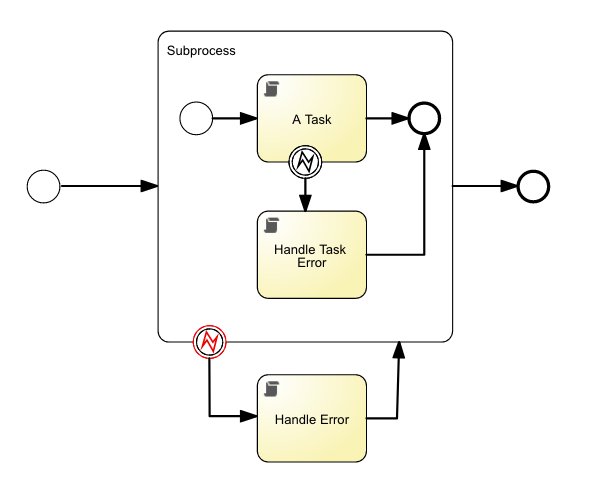
Given that A Task has an execution listener defined, which throws a BpmnError at some point: The error is only caught if the error boundary event on the Subprocess matches (the red one in the image). The error boundary event on the A Task is ignored in this case. This is a recommended practice anyway.
The reason for this is: When execution listeners are called, the activity is either not yet fully initialized (for start listeners) or the scope was already destroyed (for end listeners).
Task listener
A task listener is used to execute custom Java logic or an expression on the occurrence of a certain task-related event.
A task listener can only be added in the process definition as a child element of a user task. Note that this also must happen as a child of the BPMN 2.0 extensionElements and in the flowable namespace, since a task listener is a Flowable-specific construct.
<userTask id="myTask" name="My Task" >
<extensionElements>
<flowable:taskListener event="create" class="org.flowable.MyTaskCreateListener" />
</extensionElements>
</userTask>
A task listener supports the following attributes:
event (required): the type of task event on which the task listener will be invoked. Possible events are
create: occurs when the task has been created and all task properties are set.
assignment: occurs when the task is assigned to somebody. Note: when process execution arrives in a userTask, first an assignment event will be fired, before the create event is fired. This might seem an unnatural order, but the reason is pragmatic: when receiving the create event, we usually want to inspect all properties of the task including the assignee.
complete: occurs when the task is completed and just before the task is deleted from the runtime data.
delete: occurs just before the task is going to be deleted. Notice that it will also be executed when task is normally finished via completeTask.
class: the delegation class that must be called. This class must implement the org.flowable.task.service.delegate.TaskListener interface.
public class MyTaskCreateListener implements TaskListener {
public void notify(DelegateTask delegateTask) {
// Custom logic goes here
}
}
It is also possible to use field injection to pass process variables or the execution to the delegation class. Note that an instance of the delegation class is created on process deployment (as is the case with any class delegation in Flowable), which means that the instance is shared between all process instance executions.
- expression: (cannot be used together with the class attribute): specifies an expression that will be executed when the event happens. It is possible to pass the DelegateTask object and the name of the event (using task.eventName) as parameter to the called object.
<flowable:taskListener event="create" expression="${myObject.callMethod(task, task.eventName)}" />
- delegateExpression allows you to specify an expression that resolves to an object implementing the TaskListener interface, similar to a service task.
<flowable:taskListener event="create" delegateExpression="${myTaskListenerBean}" />
- A while back, we also introduced a new type of task listener, the org.flowable.engine.impl.bpmn.listener.ScriptTaskListener. This script task listener allows you to execute a piece of script logic for a task listener event.
<flowable:taskListener event="complete" class="org.flowable.engine.impl.bpmn.listener.ScriptTaskListener" >
<flowable:field name="script">
<flowable:string>
def bar = "BAR"; // local variable
foo = "FOO"; // pushes variable to execution context
task.setOwner("kermit"); // test access to task instance
bar // implicit return value
</flowable:string>
</flowable:field>
<flowable:field name="language" stringValue="groovy" />
<flowable:field name="resultVariable" stringValue="myVar" />
</flowable:taskListener>
- Scriptable task listeners became a first-class citizen using a more compact syntax, avoiding to hard-code the class name:
<flowable:taskListener event="complete" type="script">
<flowable:script language="groovy" resultVariable="myVar">
<![CDATA[
def bar = "BAR"; // local variable
task.setOwner("kermit"); // test access to task instance
bar // implicit return value
]]>
</flowable:script>
</flowable:taskListener>
Throwing BPMN Error in Task Listeners
Jump to section Throwing BPMN Error in Execution Listeners as the same rules apply for task listeners.
Multi-instance (for each)
Description
A multi-instance activity is a way of defining repetition for a certain step in a business process. In programming concepts, a multi-instance is equivalent to the for each construct: it allows you to execute a certain step, or even a complete sub-process, for each item in a given collection, sequentially or in parallel.
A multi-instance is a regular activity that has extra properties defined (named 'multi-instance characteristics') that will cause the activity to be executed multiple times at runtime. The following activities can become a _multi-instance activity:
A Gateway or Event cannot become multi-instance.
As required by the BPMN 2.0 specification, each parent execution of the created executions for each instance will have following variables:
nrOfInstances: the total number of instances
nrOfActiveInstances: the number of currently active (not yet finished) instances. For a sequential multi-instance, this will always be 1.
nrOfCompletedInstances: the number of already completed instances.
These values can be retrieved by calling the execution.getVariable(x) method.
Additionally, each of the created executions will have an execution-local variable (not visible for the other executions, and not stored on process instance level):
- loopCounter: indicates the index in the for-each loop of that particular instance. The loopCounter variable can be renamed using a Flowable elementIndexVariable attribute.
Graphical notation
If an activity is multi-instance, this is indicated by three short lines at the bottom of the activity. Three vertical lines indicates that the instances will be executed in parallel, while three horizontal lines indicate sequential execution.
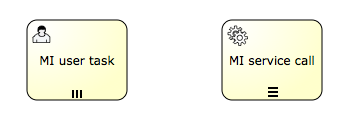
XML representation
To make an activity multi-instance, the activity XML element must have a multiInstanceLoopCharacteristics child element.
<multiInstanceLoopCharacteristics isSequential="false|true">
...
</multiInstanceLoopCharacteristics>
The isSequential attribute indicates if the instances of that activity are executed sequentially or in parallel.
The number of instances are calculated once when entering the activity. There are a few ways of configuring this. One way is directly specifying a number using the loopCardinality child element.
<multiInstanceLoopCharacteristics isSequential="false|true">
<loopCardinality>5</loopCardinality>
</multiInstanceLoopCharacteristics>
Expressions that resolve to a positive number are also allowed:
<multiInstanceLoopCharacteristics isSequential="false|true">
<loopCardinality>${nrOfOrders-nrOfCancellations}</loopCardinality>
</multiInstanceLoopCharacteristics>
Another way to define the number of instances is to specify the name of a process variable that is a collection using the loopDataInputRef child element. For each item in the collection, an instance will be created. Optionally, it is possible to set that specific item of the collection for the instance using the inputDataItem child element. This is shown in the following XML example:
<userTask id="miTasks" name="My Task ${loopCounter}" flowable:assignee="${assignee}">
<multiInstanceLoopCharacteristics isSequential="false">
<loopDataInputRef>assigneeList</loopDataInputRef>
<inputDataItem name="assignee" />
</multiInstanceLoopCharacteristics>
</userTask>
Suppose the variable assigneeList contains the values \[kermit, gonzo, fozzie\]. In the snippet above, three user tasks will be created in parallel. Each of the executions will have a process variable named assignee containing one value of the collection, which is used to assign the user task in this example.
The downside of the loopDataInputRef and inputDataItem is that the names are pretty hard to remember, and due to the BPMN 2.0 schema restrictions, they can’t contain expressions. Flowable solves this by offering the collection and elementVariable attributes on the multiInstanceCharacteristics:
<userTask id="miTasks" name="My Task" flowable:assignee="${assignee}">
<multiInstanceLoopCharacteristics isSequential="true"
flowable:collection="${myService.resolveUsersForTask()}" flowable:elementVariable="assignee" >
</multiInstanceLoopCharacteristics>
</userTask>
Note that the collection attribute will be resolved as an expression. When the expression resolves to a String instead of a collection, either because it is a static string value or the expression itself resolves to a String, the resulting value will be used as the variable name for fetching the collection process variable.
For example, in the following snippet the collection is assumed to be stored in the assigneeList process variable:
<userTask id="miTasks" name="My Task" flowable:assignee="${assignee}">
<multiInstanceLoopCharacteristics isSequential="true"
flowable:collection="assigneeList" flowable:elementVariable="assignee" >
</multiInstanceLoopCharacteristics>
</userTask>
For example, assuming the myService.getCollectionVariableName() returns a String value, that value will be used as variable name to fetch the collection stored as a process variable.
<userTask id="miTasks" name="My Task" flowable:assignee="${assignee}">
<multiInstanceLoopCharacteristics isSequential="true"
flowable:collection="${myService.getCollectionVariableName()}" flowable:elementVariable="assignee" >
</multiInstanceLoopCharacteristics>
</userTask>
A multi-instance activity ends when all instances are finished. However, it is possible to specify an expression that is evaluated every time an instance ends. When this expression evaluates to true, all remaining instances are destroyed and the multi-instance activity ends, continuing the process. Such an expression must be defined in the completionCondition child element.
<userTask id="miTasks" name="My Task" flowable:assignee="${assignee}">
<multiInstanceLoopCharacteristics isSequential="false"
flowable:collection="assigneeList" flowable:elementVariable="assignee" >
<completionCondition>${nrOfCompletedInstances/nrOfInstances >= 0.6 }</completionCondition>
</multiInstanceLoopCharacteristics>
</userTask>
In this example, there will be parallel instances created for each element of the assigneeList collection. However, when 60% of the tasks are completed, the other tasks are deleted and the process continues.
Boundary events and multi-instance
Since a multi-instance is a regular activity, it is possible to define a boundary event on its boundary. In the case of an interrupting boundary event, when the event is caught, all instances that are still active will be destroyed. Take, for example, the following multi-instance sub-process:
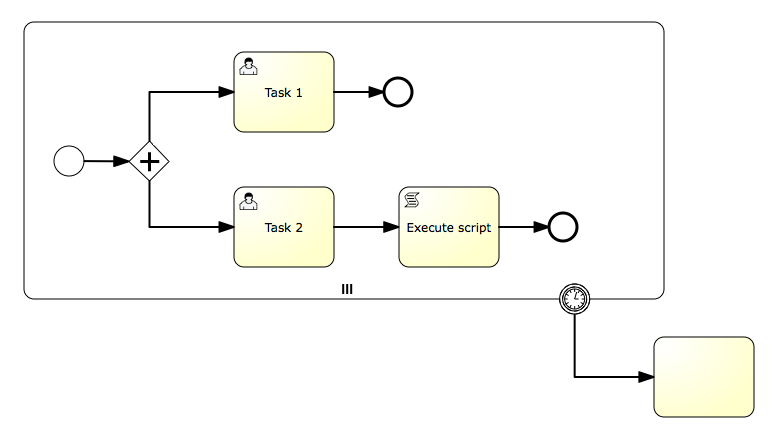
Here, all instances of the sub-process will be destroyed when the timer fires, regardless of how many instances there are or which inner activities haven’t yet completed.
Multi instance and execution listeners
There is a caveat when using execution listeners in combination with multi instance. Take, for example, the following snippet of BPMN 2.0 XML, which is defined at the same level as the multiInstanceLoopCharacteristics XML element is set:
<extensionElements>
<flowable:executionListener event="start" class="org.flowable.MyStartListener"/>
<flowable:executionListener event="end" class="org.flowable.MyEndListener"/>
</extensionElements>
For a normal BPMN activity, there will be an invocation of these listeners when the activity is started and ended.
However, when the activity is multi-instance, the behavior is different:
When the multi-instance activity is entered, before any of the inner activities is executed, a start event is thrown. The loopCounter variable is not yet set (it is null).
For each of the actual activities visited, a start event is thrown. The loopCounter variable is set.
The same logic applies for the end event:
After leaving the actual activity, an end even is thrown. The loopCounter variable is set.
When the multi-instance activity has finished as a whole, an end event is thrown. The loopCounter variable is not set.
For example:
<subProcess id="subprocess1" name="Sub Process">
<extensionElements>
<flowable:executionListener event="start" class="org.flowable.MyStartListener"/>
<flowable:executionListener event="end" class="org.flowable.MyEndListener"/>
</extensionElements>
<multiInstanceLoopCharacteristics isSequential="false">
<loopDataInputRef>assignees</loopDataInputRef>
<inputDataItem name="assignee"></inputDataItem>
</multiInstanceLoopCharacteristics>
<startEvent id="startevent2" name="Start"></startEvent>
<endEvent id="endevent2" name="End"></endEvent>
<sequenceFlow id="flow3" name="" sourceRef="startevent2" targetRef="endevent2"></sequenceFlow>
</subProcess>
In this example, suppose the assignees list has three items. The following happens at runtime:
A start event is thrown for the multi-instance as a whole. The start execution listener is invoked. The loopCounter and the assignee variables will not be set (they will be null).
A start event is thrown for each activity instance. The start execution listener is invoked three times. The loopCounter and the assignee variables will be set (not null).
So, in total, the start execution listener is invoked four times.
Note that the same applies when the multiInstanceLoopCharacteristics are defined on something other than a sub-process too. For example, if the example above was a simple userTask, the same reasoning still applies.
Compensation Handlers
Description
If an activity is used for compensating the effects of another activity, it can be declared to be a compensation handler. Compensation handlers do not exist in normal flows and are only executed when a compensation event is thrown.
Compensation handlers must not have incoming or outgoing sequence flows.
A compensation handler must be associated with a compensation boundary event using a directed association.
Graphical notation
If an activity is a compensation handler, the compensation event icon is displayed in the center bottom area. The following excerpt from a process diagram shows a service task with an attached compensation boundary event, which is associated to a compensation handler. Notice the compensation handler icon in the bottom canter area of the "cancel hotel reservation" service task.

XML representation
In order to declare an activity to be a compensation handler, we need to set the attribute isForCompensation to true:
<serviceTask id="undoBookHotel" isForCompensation="true" flowable:class="...">
</serviceTask>
Sub-Processes and Call Activities
Sub-Process
Description
A Sub-Process is an activity that contains other activities, gateways, events, and so on, which in itself forms a process that is part of the bigger process. A Sub-Process is completely defined inside a parent process (that’s why it’s often called an embedded Sub-Process).
Sub-Processes have two major use cases:
Sub-Processes allow hierarchical modeling. Many modeling tools allow Sub-Processes to be collapsed, hiding all the details of the Sub-Process, resulting in a high-level, end-to-end overview of the business process.
A Sub-Process creates a new scope for events. Events that are thrown during execution of the Sub-Process can be caught by a boundary event on the boundary of the Sub-Process, creating a scope for that event limited to the Sub-Process.
Using a Sub-Process does impose some constraints:
A Sub-Process can only have one 'none start event', no other start event types are allowed. A Sub-Process must at least have one 'end event'. Note that the BPMN 2.0 specification allows the omission of the start and end events in a Sub-Process, but the current Flowable implementation does not support this.
Sequence flows cannot cross Sub-Process boundaries.
Graphical Notation
A Sub-Process is visualized as a typical activity (a rounded rectangle). If the Sub-Process is collapsed, only the name and a plus-sign are displayed, giving a high-level overview of the process:

If the Sub-Process is expanded, the steps of the Sub-Process are displayed within the Sub-Process boundaries:
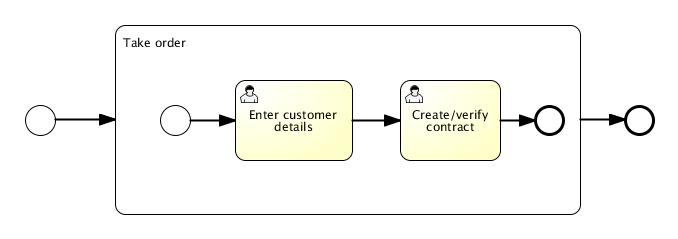
One of the main reasons to use a Sub-Process is to define a scope for a certain event. The following process model shows this: both the investigate software/investigate hardware tasks need to be done in parallel, but both tasks need to be done within a certain time, before Level 2 support is consulted. Here, the scope of the timer (in which activities must be done in time) is constrained by the Sub-Process.
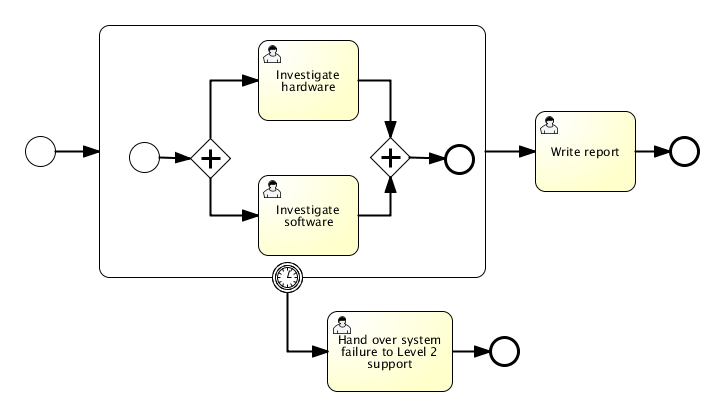
XML representation
A Sub-Process is defined by the subProcess element. All activities, gateways, events, and son on, that are part of the Sub-Process, need to be enclosed within this element.
<subProcess id="subProcess">
<startEvent id="subProcessStart" />
... other Sub-Process elements ...
<endEvent id="subProcessEnd" />
</subProcess>
Event Sub-Process
Description
The Event Sub-Process is new in BPMN 2.0. An Event Sub-Process is a sub-process that is triggered by an event. An Event Sub-Process can be added at the process level or at any sub-process level. The event used to trigger an event sub-process is configured using a start event. From this, it follows that 'none start events' are not supported for Event Sub-Processes. An Event Sub-Process might be triggered using events, such as message events, error events, signal events, timer events, or compensation events. The subscription to the start event is created when the scope (process instance or sub-process) hosting the Event Sub-Process is created. The subscription is removed when the scope is destroyed.
An Event Sub-Process may be interrupting or non-interrupting. An interrupting sub-process cancels any executions in the current scope. A non-interrupting Event Sub-Process spawns a new concurrent execution. While an interrupting Event Sub-Process can only be triggered once for each activation of the scope hosting it, a non-interrupting Event Sub-Process can be triggered multiple times. The fact of whether a sub-process is interrupting is configured using the start event triggering the Event Sub-Process.
An Event Sub-Process must not have any incoming or outgoing sequence flows. As an Event Sub-Process is triggered by an event, an incoming sequence flow makes no sense. When an Event Sub-Process is ended, either the current scope is ended (if an interrupting Event Sub-Process), or the concurrent execution spawned for the non-interrupting sub-process is ended.
Current limitations:
- Flowable supports Event Sub-Process triggered using an Error, Timer, Signal and Message Start Events.
Graphical Notation
An Event Sub-Process can be visualized as an embedded sub-process with a dotted outline.

XML representation
An Event Sub-Process is represented using XML in the same way as an embedded sub-process. In addition the attribute triggeredByEvent must have the value true:
<subProcess id="eventSubProcess" triggeredByEvent="true">
...
</subProcess>
Example
The following is an example of an Event Sub-Process triggered using an Error Start Event. The Event Sub-Process is located at the "process level", in other words, is scoped to the process instance:
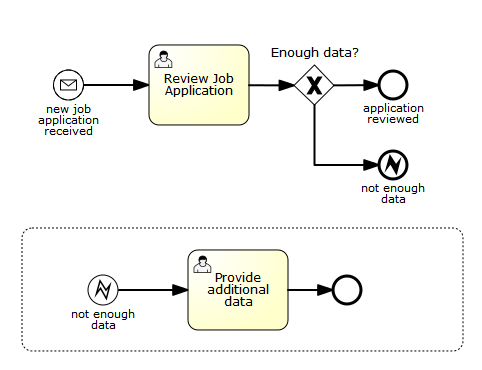
This is how the Event Sub-Process would look in XML:
<subProcess id="eventSubProcess" triggeredByEvent="true">
<startEvent id="catchError">
<errorEventDefinition errorRef="error" />
</startEvent>
<sequenceFlow id="flow2" sourceRef="catchError" targetRef="taskAfterErrorCatch" />
<userTask id="taskAfterErrorCatch" name="Provide additional data" />
</subProcess>
As already stated, an Event Sub-Process can also be added to an embedded sub-process. If it’s added to an embedded sub-process, it becomes an alternative to a boundary event. Consider the two following process diagrams. In both cases the embedded sub-process throws an error event. Both times the error is caught and handled using a user task.
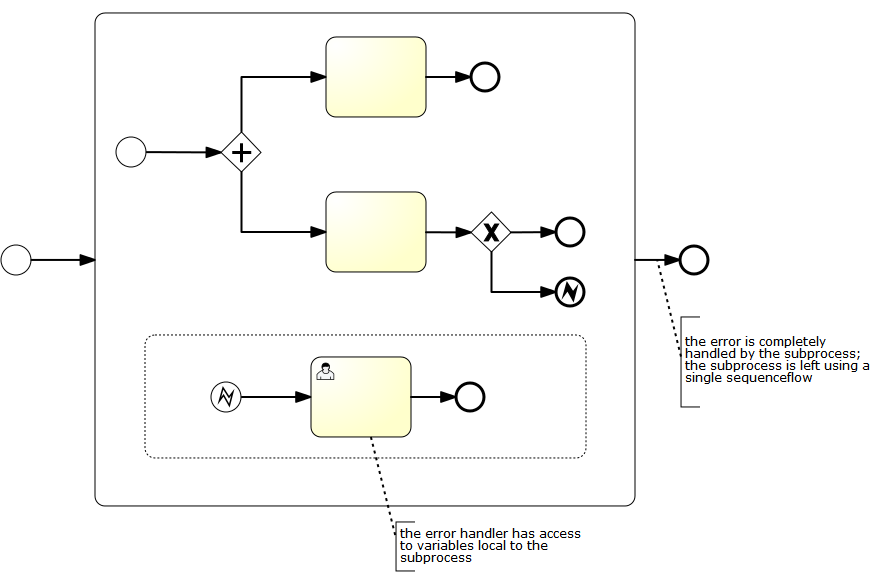
As opposed to:
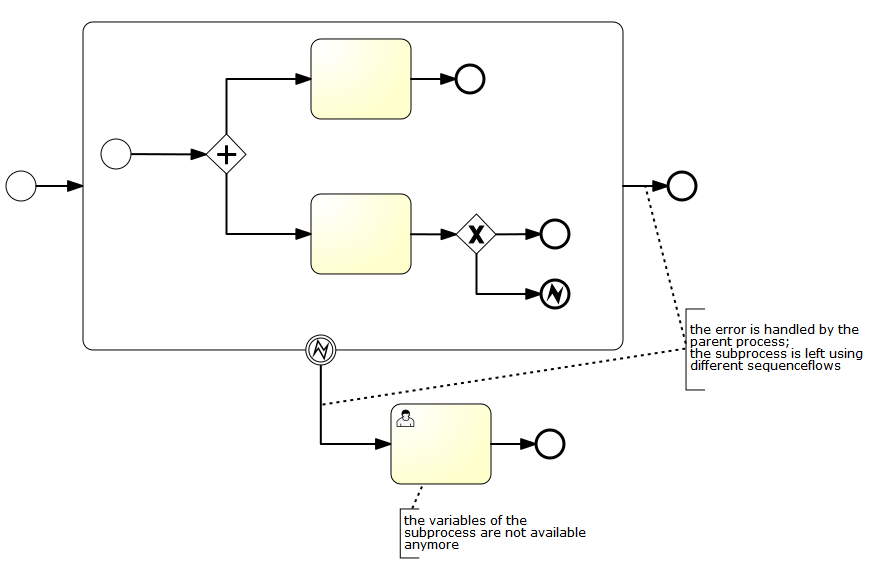
In both cases the same tasks are executed. However, there are differences between both modeling alternatives:
The embedded sub-process is executed using the same execution that executed the scope it is hosted in. This means that an embedded sub-process has access to the variables local to its scope. When using a boundary event, the execution created for executing the embedded sub-process is deleted by the sequence flow leaving the boundary event. This means that the variables created by the embedded sub-process are not available anymore.
When using an Event Sub-Process, the event is completely handled by the sub-process it is added to. When using a boundary event, the event is handled by the parent process.
These two differences can help you decide whether a boundary event or an embedded sub-process is better suited for solving a particular process modeling or implementation problem.
Transaction sub-process
Description
A transaction sub-process is an embedded sub-process that can be used to group multiple activities to a transaction. A transaction is a logical unit of work that allows to group a set of individual activities, such that they either succeed or fail collectively.
Possible outcomes of a transaction: A transaction can have three different outcomes:
A transaction is successful if it isn’t either cancelled or terminated by a hazard. If a transaction sub-process is successful, it is left using the outgoing sequence flows. A successful transaction might be compensated if a compensation event is thrown later in the process. Note: just as with "ordinary" embedded sub-processes, a transaction may be compensated after successful completion using an intermediary throwing compensation event.
A transaction is canceled if an execution reaches the cancel end event. In this case, all executions are terminated and removed. A single remaining execution is then set to the cancel boundary event, which triggers compensation. After compensation has completed, the transaction sub-process is left using the outgoing sequence flows of the cancel boundary event.
A transaction is ended by a hazard if an error event is thrown that is not caught within the scope of the transaction sub-process. This also applies if the error is caught on the boundary of the transaction sub-process. In these cases, compensation is not performed.
The following diagram illustrates the three different outcomes:

Relation to ACID transactions: it is important not to confuse the BPMN transaction sub-process with technical (ACID) transactions. The BPMN transaction sub-process is not a way to scope technical transactions. In order to understand transaction management in Flowable, read the section on concurrency and transactions. A BPMN transaction is different from a technical transaction in the following ways:
While an ACID transaction is typically short-lived, a BPMN transaction may take hours, days or even months to complete. Consider the case where one of the activities grouped by a transaction is a user task: typically people have longer response times than applications. Or, in another situation, a BPMN transaction might wait for some business event to occur, like the fact that a particular order has been fulfilled. Such operations usually take considerably longer to complete than updating a record in a database, or storing a message using a transactional queue.
Because it is impossible to scope a technical transaction to the duration of a business activity, a BPMN transaction typically spans multiple ACID transactions.
As a BPMN transaction spans multiple ACID transactions, we loose ACID properties. For example, consider the example given above. Let’s assume the "book hotel" and the "charge credit card" operations are performed in separate ACID transactions. Let’s also assume that the "book hotel" activity is successful. Now we have an intermediary inconsistent state, because we have performed a hotel booking, but have not yet charged the credit card. Now, in an ACID transaction, we would also perform different operations sequentially and thus also have an intermediary inconsistent state. What is different here, is that the inconsistent state is visible outside of the scope of the transaction. For example, if the reservations are made using an external booking service, other parties using the same booking service might already see that the hotel is booked. This means that when implementing business transactions, we completely loose the isolation property (granted, we usually also relax isolation when working with ACID transactions to allow for higher levels of concurrency, but there we have fine grained control and intermediary inconsistencies are only present for very short periods of times).
A BPMN business transaction can not be rolled back in the traditional sense. As it spans multiple ACID transactions, some of these ACID transactions might already be committed at the time the BPMN transaction is canceled. At this point, they cannot be rolled back anymore.
As BPMN transactions are long-running in nature, the lack of isolation and a rollback mechanism needs to be dealt with differently. In practice, there is usually no better solution than to deal with these problems in a domain-specific way:
The rollback is performed using compensation. If a cancel event is thrown in the scope of a transaction, the effects of all activities that executed successfully and have a compensation handler are compensated.
The lack of isolation is also often dealt with using domain-specific solutions. For instance, in the example above, a hotel room might appear to be booked to a second customer before we have actually made sure that the first customer can pay for it. As this might be undesirable from a business perspective, a booking service might choose to allow for a certain amount of overbooking.
In addition, as the transaction can be aborted in the case of a hazard, the booking service has to deal with the situation where a hotel room is booked, but payment is never attempted (since the transaction was aborted). In this case, the booking service might choose a strategy where a hotel room is reserved for a maximum period of time and if payment is not received by then, the booking is canceled.
To sum it up: while ACID transactions offer a generic solution to such problems (rollback, isolation levels and heuristic outcomes), we need to find domain-specific solutions to these problems when implementing business transactions.
Current limitations:
- The BPMN specification requires that the process engine reacts to events issued by the underlying transaction protocol and, for instance, that a transaction is cancelled if a cancel event occurs in the underlying protocol. As an embeddable engine, Flowable does not currently support this. For some ramifications of this, see the paragraph on consistency below.
Consistency on top of ACID transactions and optimistic concurrency: A BPMN transaction guarantees consistency in the sense that either all activities compete successfully, or if some activity cannot be performed, the effects of all other successful activities are compensated. So, either way, we end up in a consistent state. However, it is important to recognize that in Flowable, the consistency model for BPMN transactions is superposed on top of the consistency model for process execution. Flowable executes processes in a transactional way. Concurrency is addressed using optimistic locking. In Flowable, BPMN error, cancel and compensation events are built on top of the same ACID transactions and optimistic locking. For example, a cancel end event can only trigger compensation if it is actually reached. It is not reached if some undeclared exception is thrown by a service task before. Or, the effects of a compensation handler cannot be committed if some other participant in the underlying ACID transaction sets the transaction to the state rollback-only. Or, when two concurrent executions reach a cancel end event, compensation might be triggered twice and fail with an optimistic locking exception. All of this is to say that when implementing BPMN transactions in Flowable, the same set of rules apply as when implementing "ordinary" processes and sub-processes. So, to effectively guarantee consistency, it is important to implement processes in a way that does take the optimistic, transactional execution model into consideration.
Graphical Notation
A transaction sub-process is visualized as a an embedded sub-process with a double outline.
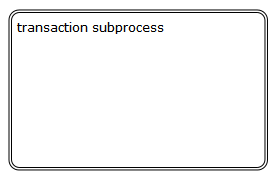
XML representation
A transaction sub-process is represented in XML using the transaction tag:
<transaction id="myTransaction" >
...
</transaction>
Example
The following is an example of a transaction sub-process:

Call activity (sub-process)
Description
BPMN 2.0 makes a distinction between a regular sub-process, often also called embedded sub-process, and the call activity, which looks very similar. From a conceptual point of view, both will call a sub-process when the process execution arrives at the activity.
The difference is that the call activity references a process that is external to the process definition, whereas the sub-process is embedded within the original process definition. The main use case for the call activity is to have a reusable process definition that can be called from multiple other process definitions.
When process execution arrives at the call activity, a new execution is created that is a sub-execution of the execution that arrived at the call activity. This sub-execution is then used to execute the sub-process, potentially creating parallel child executions, as within a regular process. The super-execution waits until the sub-process has completely ended, and continues with the original process afterwards.
Graphical Notation
A call activity is visualized in the same way as a sub-process, but with a thick border (collapsed and expanded). Depending on the modeling tool, a call activity can also be expanded, but the default visualization is the collapsed sub-process representation.

XML representation
A call activity is a regular activity, which requires a calledElement that references a process definition by its key. In practice, this means that the ID of the process is used in the calledElement.
<callActivity id="callCheckCreditProcess" name="Check credit" calledElement="checkCreditProcess" />
Note that the process definition of the sub-process is resolved at runtime. This means that the sub-process can be deployed independently from the calling process, if needed.
Passing variables
You can pass process variables to the sub-process and vice versa. The data is copied into the sub-process when it is started and copied back into the main process when it ends.
<callActivity id="callSubProcess" calledElement="checkCreditProcess">
<extensionElements>
<flowable:in source="someVariableInMainProcess"
target="nameOfVariableInSubProcess" />
<flowable:out source="someVariableInSubProcess"
target="nameOfVariableInMainProcess" />
</extensionElements>
</callActivity>
You can pass all process variables to the sub-process by setting the option inheritVariables to true.
<callActivity id="callSubProcess" calledElement="checkCreditProcess" flowable:inheritVariables="true"/>
We provide a Flowable Extension as a shortcut for the BPMN standard elements, named dataInputAssociation and dataOutputAssociation, which only work if you declare process variables in the BPMN 2.0 standard way.
It is possible to use expressions here as well:
<callActivity id="callSubProcess" calledElement="checkCreditProcess" >
<extensionElements>
<flowable:in sourceExpression="${x+5}" target="y" />
<flowable:out source="${y+5}" target="z" />
</extensionElements>
</callActivity>
So, in the end z = y+5 = x+5+5.
The callActivity element also supports setting the business key on the sub-process instance using a custom Flowable attribute extension. The 'businessKey' attribute can be used to set a custom business key value on the sub-process instance.
<callActivity id="callSubProcess" calledElement="checkCreditProcess" flowable:businessKey="${myVariable}">
...
</callActivity>
Defining the 'inheritBusinessKey' attribute with a value of true will set the business key value on the sub-process to the value of the business key as defined in the calling process.
<callActivity id="callSubProcess" calledElement="checkCreditProcess" flowable:inheritBusinessKey="true">
...
</callActivity>
Reference the process from the same deployment
The default behavior is that the latest deployed process definition is taken to start the referenced process. There are use cases where you would like to deploy the referenced process from the same deployment as the main process to use the same state of the referenced process at the time of the deployment. This requires that you deploy the main and the referenced process within the same deployment unit, such that the process definitions have the same reference to the deployment.
To use the referenced process from the same deployment you can set the sameDeployment attribute to true on the callActivity element
like in the following example:
<callActivity id="callSubProcess" calledElement="checkCreditProcess" flowable:sameDeployment="true">
...
</callActivity>
By default the sameDeployment attribute is set to false.
The callActivity element provides fallback option in the case when process definition was not found by key in the current tenant. When attribute fallbackToDefaultTenant is set to true. callActivity searches for process definition by key in definitions without tenant.
<callActivity id="callSubProcess" calledElement="checkCreditProcess" flowable:fallbackToDefaultTenant="true" >
...
</callActivity>
The default value is false.
Reference the process definition by id
The default behavior is that the latest deployed process definition is taken to start the referenced process by key. There are use cases where you would like to reference exact process definition by its id.
To use the referenced process definition by its id use flowable:calledElementType with the value id. Allowed values are key and id.
<callActivity id="callSubProcess" calledElement="UNIQUE-PROCESS_DEFINITION-ID" flowable:calledElementType="id">
...
</callActivity>
By default the flowable:calledElementType attribute is set to key.
Example
The following process diagram shows a simple handling of an order. As the checking of the customer’s credit could be common to many other processes, the check credit step is modeled here as a call activity.

The process looks as follows:
<startEvent id="theStart" />
<sequenceFlow id="flow1" sourceRef="theStart" targetRef="receiveOrder" />
<manualTask id="receiveOrder" name="Receive Order" />
<sequenceFlow id="flow2" sourceRef="receiveOrder" targetRef="callCheckCreditProcess" />
<callActivity id="callCheckCreditProcess" name="Check credit" calledElement="checkCreditProcess" />
<sequenceFlow id="flow3" sourceRef="callCheckCreditProcess" targetRef="prepareAndShipTask" />
<userTask id="prepareAndShipTask" name="Prepare and Ship" />
<sequenceFlow id="flow4" sourceRef="prepareAndShipTask" targetRef="end" />
<endEvent id="end" />
The sub-process looks as follows:
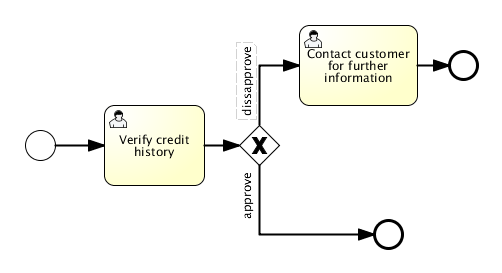
There is nothing special about the process definition of the sub-process. It could as well be used without being called from another process.
Async completion
In some particular use cases, it’s needed to make the completion of the call activity asynchronous (and exclusive).
Take the following process definition. Let’s assume the called process definition consists of only service tasks which are marked as asynchronous and exclusive. All the steps of these sub process instances will be executed asynchronously. When the last asynchronous service task is executed, the end event will be visited. At that point, the control will be passed back to the parent process instance.

The problem is that asynchronous locking happens on the process instance level. In this cases, the child process instances will be locked when the last service task and event event are visited. This means that when the control is passed back to the parent process instance, and thus when the call activity completes, the parent process instance is not locked. When multi-instance is used, this means that x number of instances try to complete the call activity. Even when using exclusive on all steps, this still would mean every child process instance concurrently will try to update the parent process instance, potentially leading to FlowableOptimisticLockingExceptions as the 'wrong' process instance is used for the exclusive lock.
The solution to this problem is to mark the async complete flag for the call activity. When true, a new asynchronous job will be created, using the parent process instance. When the exclusive lock is created, it will be held for parent process instance and the multi instance completion of the call activity will be handled exclusively for each child execution separately.
Transactions and Concurrency
Asynchronous Continuations
Flowable executes processes in a transactional way that can be configured to suite your needs. Let’s start by looking at how Flowable scopes transactions normally. If you trigger Flowable (start a process, complete a task, signal an execution), Flowable is going to advance in the process until it reaches wait states on each active path of execution. More concretely speaking, it performs a depth-first search through the process graph and returns if it has reached wait states on every branch of execution. A wait state is a task that is performed "later", which means that Flowable persists the current execution and waits to be triggered again. The trigger can either come from an external source, for example, if we have a user task or a receive message task, or from Flowable itself if we have a timer event. This is illustrated in the following picture:
We see a segment of a BPMN process with a user task, a service task and a timer event. Completing the user task and validating the address is part of the same unit of work, so it should succeed or fail atomically. That means that if the service task throws an exception, we want to rollback the current transaction, such that the execution tracks back to the user task and the user task is still present in the database. This is also the default behavior of Flowable. In (1) an application or client thread completes the task. In that same thread, Flowable is now executing the service and advances until it reaches a wait state, in this case, the timer event (2). Then it returns the control to the caller (3), potentially committing the transaction (if it was started by Flowable).
In some cases this is not what we want. Sometimes we need custom control over transaction boundaries in a process, in order to be able to scope logical units of work. This is where asynchronous continuations come into play. Consider the following process (fragment):
This time we are completing the user task, generating an invoice and then sending that invoice to the customer. This time the generation of the invoice is not part of the same unit of work, so we do not want to rollback the completion of the user task if generating an invoice fails. What we want Flowable to do is complete the user task (1), commit the transaction and return the control to the calling application. Then we want to generate the invoice asynchronously, in a background thread. This background thread is the Flowable job executor (actually a thread pool) that periodically polls the database for jobs. Behind the scenes, when we reach the "generate invoice" task, we are creating a job "message" for Flowable to continue the process later and persisting it into the database. This job is then picked up by the job executor and executed. We are also giving the local job executor a little hint that there is a new job, to improve performance.
In order to use this feature, we can use the flowable:async="true" extension. So, for example, the service task would look like this:
<serviceTask id="service1" name="Generate Invoice"
flowable:class="my.custom.Delegate"
flowable:async="true" />
flowable:async can be specified on the following BPMN task types: task, serviceTask, scriptTask, businessRuleTask, sendTask, receiveTask, userTask, subProcess, callActivity
On a userTask, receiveTask or other wait states, the async continuation allows us to execute the start execution listeners in a separate thread/transaction.
Fail Retry
Flowable, in its default configuration, reruns a job three times if there’s any exception in the execution of a job. This is also true for asynchronous jobs. In some cases more flexibility is required, and two additional parameters can be configured:
Number of retries
Delay between retries
These parameters can be configured by the flowable:failedJobRetryTimeCycle element. Here is a sample usage:
<serviceTask id="failingServiceTask" flowable:async="true"
flowable:class="org.flowable.engine.test.jobexecutor.RetryFailingDelegate">
<extensionElements>
<flowable:failedJobRetryTimeCycle>R5/PT7M</flowable:failedJobRetryTimeCycle>
</extensionElements>
</serviceTask>
Time cycle expression follows ISO 8601 standard, just like timer event expressions. The example above makes the job executor retry the job 5 times and wait 7 minutes between before each retry.
Exclusive Jobs
In recent releases, the JobExecutor makes sure that jobs from a single process instance are never executed concurrently. Why is this?
Why exclusive Jobs?
Consider the following process definition:

We have a parallel gateway followed by three service tasks that all perform an asynchronous continuation. As a result of this, three jobs are added to the database. Once such a job is present in the database it can be processed by the JobExecutor. The JobExecutor acquires the jobs and delegates them to a thread pool of worker threads that actually process the jobs. This means that by using an asynchronous continuation, you can distribute the work to this thread pool (and in a clustered scenario even across multiple thread pools in the cluster). This is usually a good thing. However, it also has an inherent problem: consistency. Consider the parallel join after the service tasks. When execution of a service task is completed, we arrive at the parallel join and need to decide whether to wait for the other executions or whether we can move forward. That means, for each branch arriving at the parallel join, we need to take a decision whether we can continue or whether we need to wait for one or more other executions on the other branches.
Why is this a problem? As the service tasks are configured using an asynchronous continuation, it is possible that the corresponding jobs are all acquired at the same time and delegated to different worker threads by the JobExecutor. The consequence is that the transactions in which the services are executed and in which the three individual executions arrive at the parallel join can overlap. If they do so, each individual transaction will not "see", that another transaction is arriving at the same parallel join concurrently and therefore assume that it has to wait for the others. However, if each transaction assumes that it has to wait for the other ones, none will continue the process after the parallel join and the process instance will remain in that state forever.
How does Flowable address this problem? Flowable performs optimistic locking. Whenever we take a decision based on data that might not be current (because another transaction might modify it before we commit), we make sure to increment the version of the same database row in both transactions. This way, whichever transaction commits first wins and the other ones fail with an optimistic locking exception. This solves the problem in the case of the process discussed above: if multiple executions arrive at the parallel join concurrently, they all assume that they have to wait, increment the version of their parent execution (the process instance) and then try to commit. Whichever execution is first will be able to commit and the other ones will fail with an optimistic locking exception. As the executions are triggered by a job, Flowable will retry to perform the same job after waiting for a certain amount of time and hopefully this time pass the synchronizing gateway.
Is this a good solution? As we have seen, optimistic locking allows Flowable to prevent inconsistencies. It makes sure that we do not "stay stuck at the joining gateway", meaning: either all executions have passed the gateway, or there are jobs in the database making sure that we retry passing it. However, while this is a perfectly fine solution from the point of view of persistence and consistency, this might not always be desirable behavior at a higher level:
Flowable will retry the same job for a fixed maximum number of times only ('3' in the default configuration). After that, the job will still be present in the database but will not be retried actively anymore. That means that an external operator would need to trigger the job manually.
If a job has non-transactional side effects, these will not be rolled back by the failing transaction. For instance, if the "book concert tickets" service does not share the same transaction as Flowable, we might book multiple tickets if we retry the job.
What are exclusive jobs?
An exclusive job cannot be performed at the same time as another exclusive job from the same process instance. Consider the process shown above: if we declare the service tasks to be exclusive, the JobExecutor will make sure that the corresponding jobs are not executed concurrently. Instead, it will make sure that whenever it acquires an exclusive job from a certain process instance, it acquires all other exclusive jobs from the same process instance and delegate them to the same worker thread. This ensures sequential execution of the jobs.
How can I enable this feature? In recent releases, exclusive jobs are the default configuration. All asynchronous continuations and timer events are exclusive by default. In addition, if you want a job to be non-exclusive, you can configure it as such using flowable:exclusive="false". For example, the following service task is asynchronous but non-exclusive.
<serviceTask id="service" flowable:expression="${myService.performBooking(hotel, dates)}"
flowable:async="true" flowable:exclusive="false" />
Is this a good solution? We’ve had some people asking whether this was a good solution. Their concern was that this would prevent you from "doing things" in parallel and would consequently be a performance problem. Again, two things have to be taken into consideration:
It can be turned off if you’re an expert and know what you are doing (and have understood the section on "Why exclusive Jobs?"). Other than that, it’s more intuitive for most users if things such as asynchronous continuations and timers just work.
It’s not actually a performance issue. Performance is an issue under heavy load. Heavy load means that all worker threads of the job executor are busy all the time. With exclusive jobs, Flowable will simply distribute the load differently. Exclusive jobs means that jobs from a single process instance are performed by the same thread sequentially. But consider: you have more than one single process instance. Jobs from other process instances are delegated to other threads and executed concurrently. This means that with exclusive jobs, Flowable will not execute jobs from the same process instance concurrently, but it will still execute multiple instances concurrently. From an overall throughput perspective, this is desirable in most scenarios as it usually leads to individual instances being done more quickly. Furthermore, data that is required for executing subsequent jobs of the same process instance will already be in the cache of the executing cluster node. If the jobs do not have this node affinity, that data might need to be fetched from the database again.
Process Initiation Authorization
By default, everyone is allowed to start a new process instance of deployed process definitions. The process initiation authorization functionality allows you to define users and groups so that web clients can optionally restrict the users who can start a new process instance. NOTE that the authorization definition is NOT validated by the Flowable engine in any way. This functionality is only meant for developers to ease the implementation of authorization rules in a web client. The syntax is similar to the syntax of user assignment for a user task. A user or group can be assigned as the potential initiator of a process using <flowable:potentialStarter> tag. Here is an example:
<process id="potentialStarter">
<extensionElements>
<flowable:potentialStarter>
<resourceAssignmentExpression>
<formalExpression>group2, group(group3), user(user3)</formalExpression>
</resourceAssignmentExpression>
</flowable:potentialStarter>
</extensionElements>
<startEvent id="theStart"/>
...
In the above XML excerpt, 'user(user3)' refers directly to the user 'user3', and 'group(group3)' to group 'group3'. No indicator will default to a group type. It is also possible to use attributes of the <process> tag, namely <flowable:candidateStarterUsers> and <flowable:candidateStarterGroups>. Here is an example:
<process id="potentialStarter" flowable:candidateStarterUsers="user1, user2"
flowable:candidateStarterGroups="group1">
...
It is possible to use both attributes simultaneously.
After the process initiation authorizations are defined, a developer can retrieve the authorization definition using the following methods. This code retrieves the list of process definitions that can be initiated by the given user:
processDefinitions = repositoryService.createProcessDefinitionQuery().startableByUser("userxxx").list();
It’s also possible to retrieve all identity links that are defined as potential initiators for a specific process definition
identityLinks = repositoryService.getIdentityLinksForProcessDefinition("processDefinitionId");
The following example shows how to get list of users who can initiate the given process:
List<User> authorizedUsers = identityService().createUserQuery()
.potentialStarter("processDefinitionId")
.list();
In exactly the same way, the list of groups that is configured as a potential starter to a given process definition can be retrieved:
List<Group> authorizedGroups = identityService().createGroupQuery()
.potentialStarter("processDefinitionId")
.list();
Data objects
BPMN provides the possibility to define data objects as part of a process or sub process element. According to the BPMN specification it’s possible to include complex XML structures that might be imported from XSD definitions. As a first start to support data objects in Flowable the following XSD types are supported:
<dataObject id="dObj1" name="StringTest" itemSubjectRef="xsd:string"/>
<dataObject id="dObj2" name="BooleanTest" itemSubjectRef="xsd:boolean"/>
<dataObject id="dObj3" name="DateTest" itemSubjectRef="xsd:datetime"/>
<dataObject id="dObj4" name="DoubleTest" itemSubjectRef="xsd:double"/>
<dataObject id="dObj5" name="IntegerTest" itemSubjectRef="xsd:int"/>
<dataObject id="dObj6" name="LongTest" itemSubjectRef="xsd:long"/>
The data object definitions will be automatically converted to process variables using the 'name' attribute value as the name for the new variable. In addition to the definition of the data object, Flowable also provides an extension element to assign a default value to the variable. The following BPMN snippet provides an example:
<process id="dataObjectScope" name="Data Object Scope" isExecutable="true">
<dataObject id="dObj123" name="StringTest123" itemSubjectRef="xsd:string">
<extensionElements>
<flowable:value>Testing123</flowable:value>
</extensionElements>
</dataObject>
...